Chamberlain Group The 350 Swing Gate Operator User Manual 01 36883D indd
Chamberlain Group Inc, The Swing Gate Operator 01 36883D indd
Manual
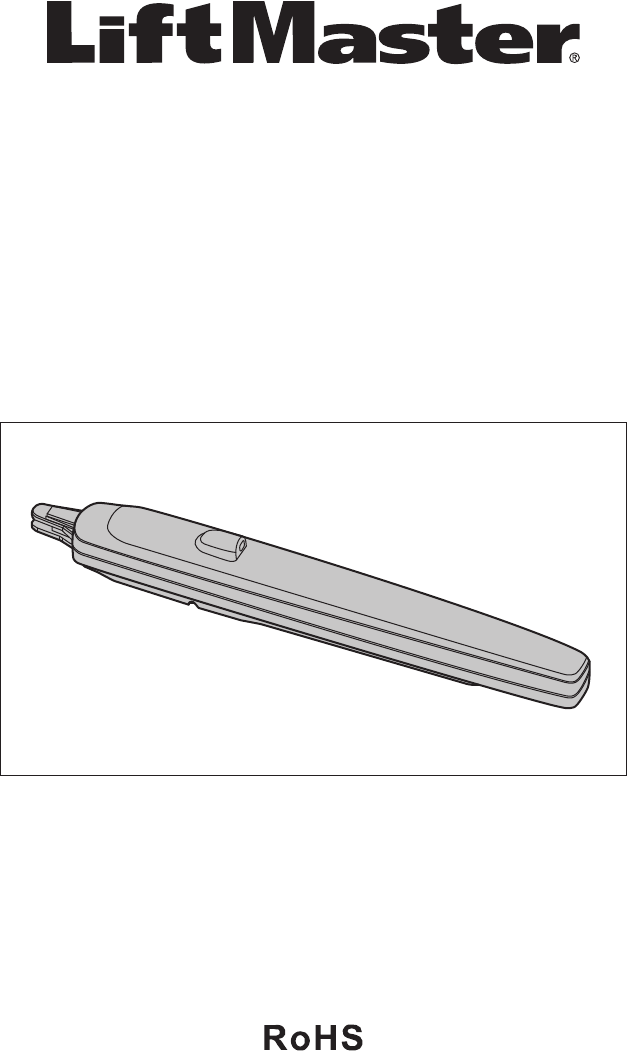
PLEASE READ THE MANUAL CAREFULLY BEFORE INSTALLATION AND OPERATION
THIS PRODUCT TO BE INSTALLED BY A TRAINED
GATE SYSTEMS TECHNICIAN ONLY.
LA350
SWING GATE OPERATOR
INSTALLATION MANUAL

2
TABLE OF CONTENTS
SAFETY ................................................................................................................................................ 3-5
INTRODUCTION
Specifications ...........................................................................................................................................6
Carton Inventory ......................................................................................................................................6
Tools Needed ...........................................................................................................................................7
Overview of Gate Operator and Wiring for Control Box ...........................................................................7
INSTALLATION
Determine the Position of the Post Bracket .............................................................................................8
Dimensions of Gate Operator ...................................................................................................................9
Determine the Position of the Gate Bracket ..................................................................................... 10-11
Adjust Travel Distance ...........................................................................................................................11
Clutch Release .......................................................................................................................................12
Install the Control Box ...........................................................................................................................12
WIRING
Connect the Gate Operator to the Control Box .......................................................................................13
Connect the Second Gate Operator to the Control Box ..........................................................................13
Voltage Selection ...................................................................................................................................14
Power Wiring .........................................................................................................................................14
Connect a Battery Backup to the Control Box (Optional) .......................................................................16
Wiring Diagram ......................................................................................................................................17
TRAVEL LIMIT SETTINGS ...................................................................................................................... 18
PROGRAMMING
Program Remote Control .......................................................................................................................18
Erase All Codes ......................................................................................................................................18
LiftMaster® Internet Gateway .................................................................................................................19
Erase a LiftMaster® Internet Gateway ....................................................................................................19
SETTINGS
Opening/Closing Delay Time Settings ....................................................................................................20
Single Gate Leaf Operation Setting ........................................................................................................20
Operation Mode Setting .........................................................................................................................20
Auto Closing Setting ..............................................................................................................................20
Force Adjustment ...................................................................................................................................21
Soft Start and Stop Speed Setting .........................................................................................................21
Moving Speed Setting ............................................................................................................................21
Operating Time Setting ..........................................................................................................................21
Maglock (Optional) ................................................................................................................................22
Flashing Light (Optional) .......................................................................................................................22
The Photoelectric Sensor (Optional) Connection ...................................................................................22
OPERATION AND MAINTENANCE .................................................................................................... 23-25
TROUBLESHOOTING .............................................................................................................................26
SERVICE KITS ........................................................................................................................................27
ACCESSORIES .......................................................................................................................................27
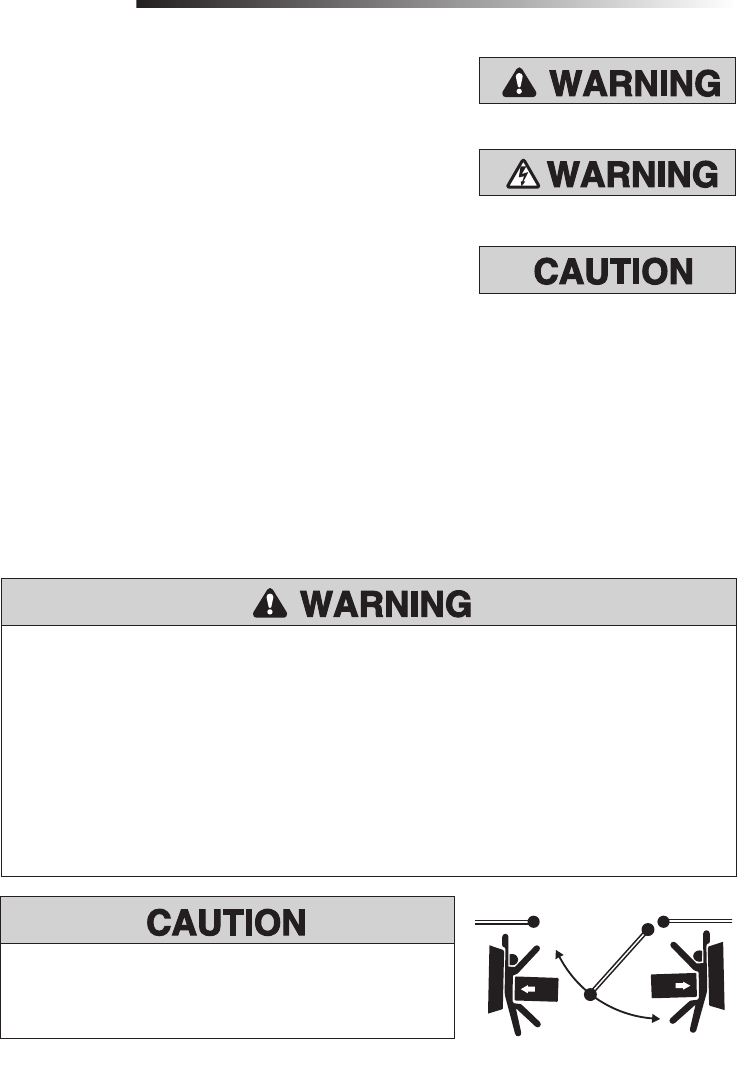
3
MECHANICAL
ELECTRICAL
When you see these Safety Symbols and Signal Words on
the following pages, they will alert you to the possibility of
serious injury or death if you do not comply with the warnings
that accompany them. The hazard may come from something
mechanical or from electric shock. Read the warnings carefully.
When you see this Signal Word on the following pages, it will
alert you to the possibility of damage to your gate and/or the gate
operator if you do not comply with the cautionary statements that
accompany it. Read them carefully.
Safety Precautions For Swing and Ornamental Grill Type Gates
SAFETY
To prevent SERIOUS INJURY or DEATH from a moving gate:
• Entrapment protection devices MUST be installed to protect anyone who may come
near a moving gate.
• Locate entrapment protection devices to protect in BOTH the open and close gate
cycles.
• Locate entrapment protection devices to protect between moving gate and RIGID
objects, such as posts.
• A swinging gate shall NOT open into public access ways.
• SAVE THESE INSTRUCTIONS.
We recommend to use E-locks/Maglock against
vandalism and if gate is installed where strong winds
may appear.
IMPORTANT NOTE
• BEFORE attempting to install, operate or maintain the operator, you must read and fully understand
this manual and follow all safety instructions.
• These instructions are intended to highlight certain safety related issues. These instructions are
not intended to be comprehensive. Because each application is unique, it is the responsibility of
the purchaser, designer, installer and end user to ensure that the total gate system is safe for its
intended use.
• Save These Instructions.

4
To reduce the risk of SEVERE INJURY or DEATH from an incorrect installation:
1. Vehicular gate systems provide convenience and security. Gate systems are comprised
of many component parts. The gate operator is only one component. Each gate
system is specifically designed for an individual application.
2. Gate operating system designers, installers and users must take into account the
possible hazards associated with each individual application. Improperly designed,
installed or maintained systems can create risks for the user as well as the bystander.
Gate systems design and installation must reduce public exposure to potential
hazards.
3. A gate operator can create high levels of force in its function as a component part of a
gate system. Therefore, safety features must be incorporated into every design.
Specific safety features include:
• Gate Edges • Guards for exposed rollers • Photoelectric Sensors
• Screen Mesh • Vertical Posts • Instructional and Precautionary Signage
4. Install the gate operator only when:
a. The operator is appropriate for the construction and the usage of the gate.
b. All openings of a horizontal swing gate are guarded or screened from the bottom of
the gate to a minimum of 4’ (1.2 m) above the ground to prevent a 2 1/4" (6 cm)
diameter sphere from passing through the openings anywhere in the gate, and in
that portion of the adjacent fence that the gate covers in the open position.
c. All exposed pinch points are eliminated or guarded, and guarding is supplied for
exposed rollers.
5. The operator is intended for installation on gates used for vehicles. Pedestrians should
be supplied with a separate access opening.
6. The gate must be installed in a location so that enough clearance is supplied between
the gate and adjacent structures when opening and closing to reduce the risk of
entrapment. Swinging gates shall not open into public access areas.
7. The gate must be properly installed and work freely in both directions prior to the
installation of the gate operator.
8. Controls must be far enough from the gate so that the user is prevented from coming
in contact with the gate while operating the controls.
SAFETY
IMPORTANT SAFETY INFORMATION
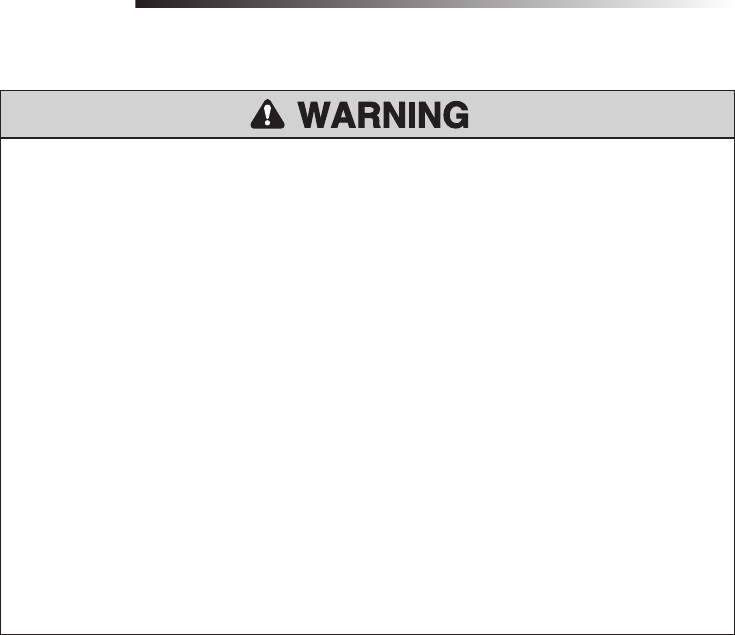
5
SAFETY
9. For a gate operator utilizing a non-contact sensor:
a. Reference owner’s manual regarding placement of non-contact sensor for each
type of application.
b. Care shall be exercised to reduce the risk of nuisance tripping, such as when a
vehicle trips the sensor while the gate is still moving.
c. One or more non-contact sensors shall be located where the risk of entrapment or
obstruction exists, such as the perimeter reachable by a moving gate or barrier.
10. For a gate operator utilizing a contact sensor such as an edge sensor:
a. A hard wired contact sensor shall be located and its wiring arranged so the
communication between the sensor and the gate operator is not subject to
mechanical damage.
b. A wireless contact sensor such as the one that transmits radio frequency (RF)
signals to the gate operator for entrapment protection functions shall be located
where the transmission of the signals are not obstructed. A wireless contact sensor
shall function under the intended end-use conditions.
c. One or more contact sensors shall be located on the inside and outside leading
edge of a swing gate. Additionally, if the bottom edge of a swing gate is greater
than 6" (15 cm) above the ground at any point in its arc of travel, one or more
contact sensors shall be located on the bottom edge.
IMPORTANT SAFETY INFORMATION
IMPORTANT:
The MyQ feature and its accessories are not permitted for use in the countries
of Peru and Chile.
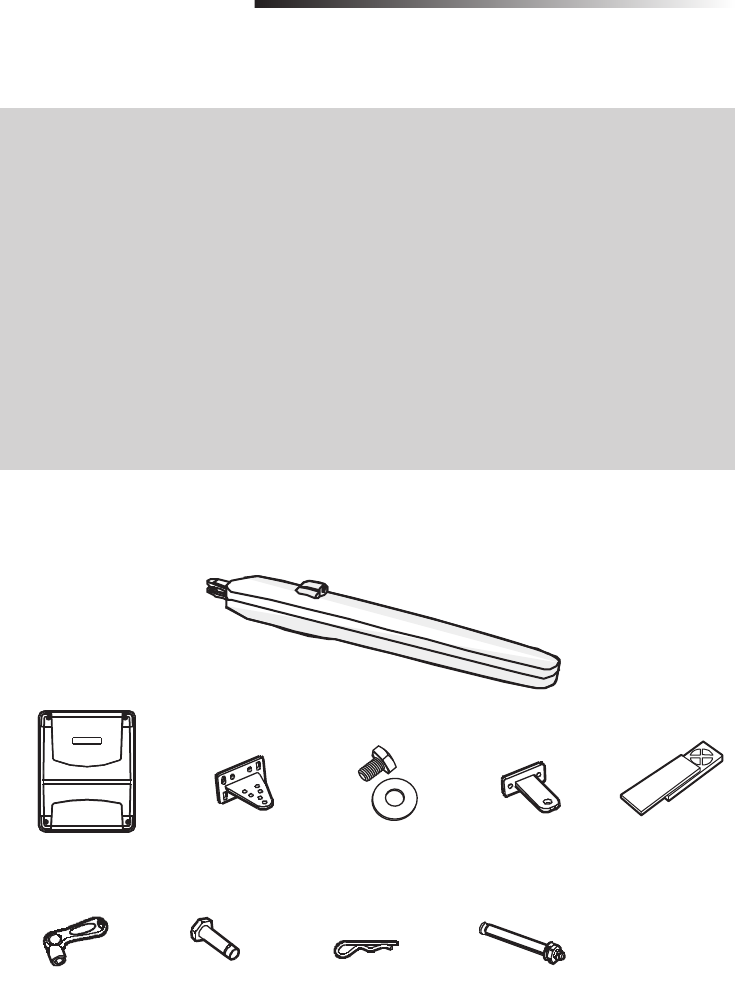
6
Specifications
INTRODUCTION
Carton Inventory
Main AC Supply: 110-127Vac / 220-240Vac; 50/60Hz
Motor Voltage: 24 Vdc
Input Power: 100 W
Ambient Temperature Range: -25 ~ +50 ˚C
Maximum Weight for single Gate Leaf: 350 Kg
Maximum Width for single Gate Leaf: 1.8 m, 2.5 m (with electric lock)
Maximum Open Angle: 120˚
Protection Level: IP 44
Maximum Travel Distance: 350 mm
Daily Cycle Rate: Maximum 50 cycles per day
Weight per Gate Operator: 6 Kg
Installation
Manual
(Not shown)
Remote Control (2)Post Mounting
Bracket (2) Gate Mounting
Bracket (2)
Washer and Bolt
(attached to the arm)
Control Box
Release Key (3) Hairpin Clip (2)Clevis Pin (2) M8x60 Screws (8)
Operator
Model LA350 (2)
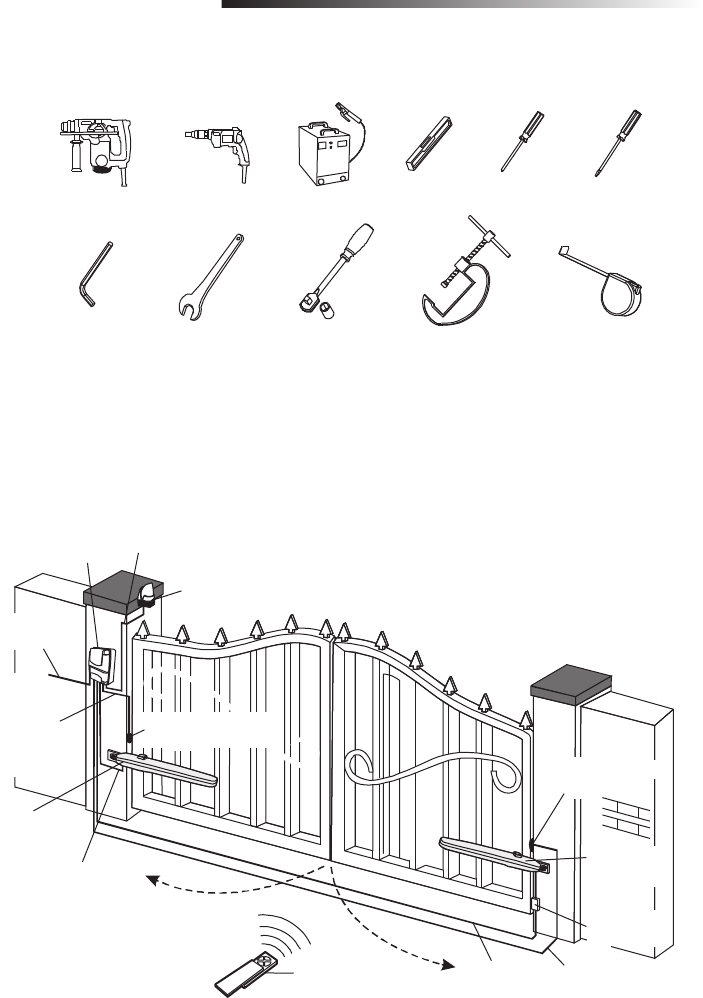
7
Overview of Gate Operator and Wiring for Control Box
Tools Needed
LA350
Gate Operator
with 1000 mm
cable
Cable for
Photoelectric Sensor:
4 X O.5 mm2 or
2 X O.5 mm2 (optional)
Extension Cables
for MOTO2:
2 X 1.0 mm2
(not supplied)
Cable for Flashing
Light: 2 X 1.O mm2
(optional)
Remote
Control
FA42LM
Flashing Light
(optional)
FA70LM
Control Box
LA350
Gate Operator
with 1000 mm
cable
Power Cable:
2 X 1.5 mm2
Cables for
MOTO1
& MOTO2:
2 X 1.0 mm2
FA31LM Photoelectric
Sensor (optional)
Cable for
Photoelectric
Sensor:
4 X O.5 mm2
or 2 X O.5 mm2
(optional)
Junction Box
(not supplied)
FA31LM Photoelectric
Sensor (optional)
Cables used must meet all National and Local Codes for outdoor use.
INTRODUCTION
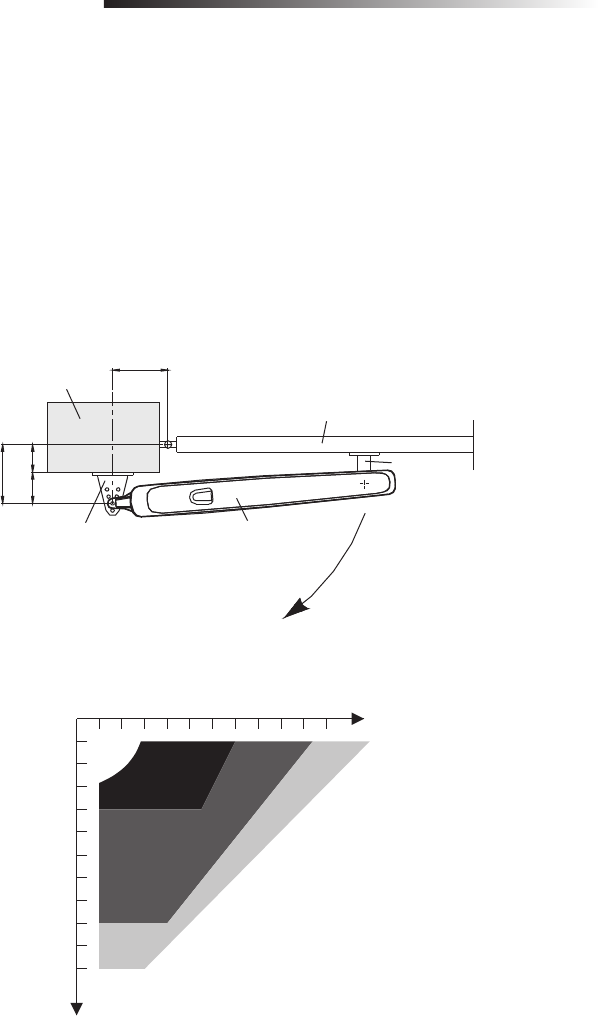
8
Determine the Position of the Post Bracket
1. Measure the Value C.
2. Value D will depend on the position where the post bracket is mounted.
3. Value A is the total length for both C and D.
4. Value B will depend on Value A and the maximum opening angle of the gate. Refer to
Table 1 below.
NOTE: For optimal mechanical advantage Value B must be close or equal to Value A.
5. Determine the A and B measurements provided in Table 1 to confi rm the position where the post
bracket will be mounted.
A
B
D
C
Gate
Gate Operator
Post Bracket
Gate Bracket
Gate Post
100
110
120
130
140
150
160
170
180
190
200
100
110
120
130
140
150
160
170
180
190
200
Max 120˚
Max 110˚
Max 100˚
Max 90˚
A
B
Unit = mm
Table 1 Maximum Gate Opening
INSTALLATION
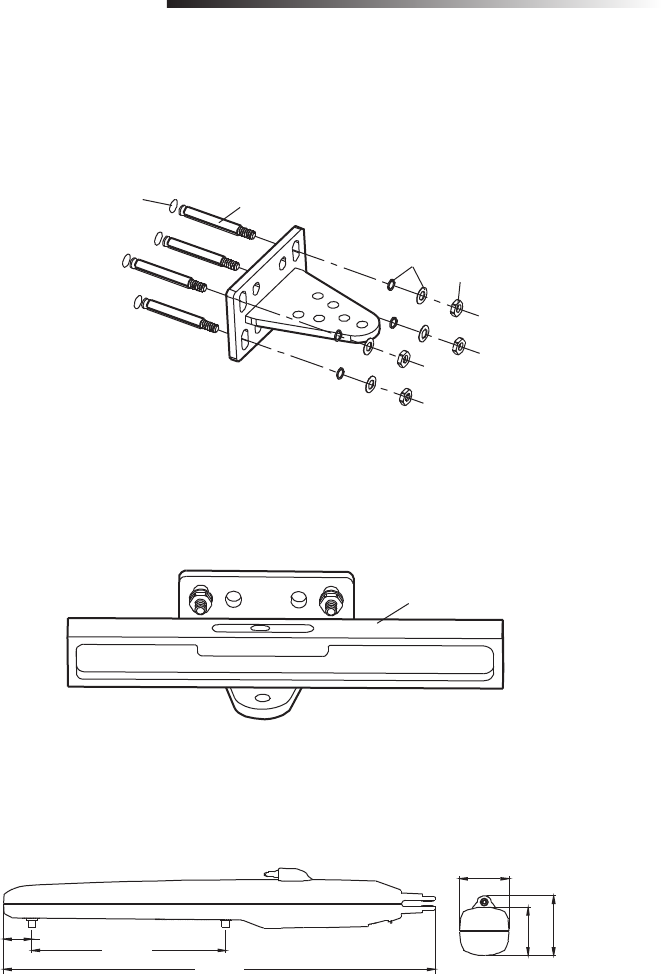
9
6. Using the post bracket as a reference, mark and drill the holes for the post bracket.
7. Attach the post bracket with the M8x60 screws, washers, and nuts.
8. The slots on the post bracket allow for alignment. When the post bracket is level tighten the nuts.
Level
Drill hole M8x60 screw
Washers
Nut
55 mm
115.3 mm
93.5 mm
95 mm
835 mm
350 mm
Dimensions of Gate Operator
INSTALLATION
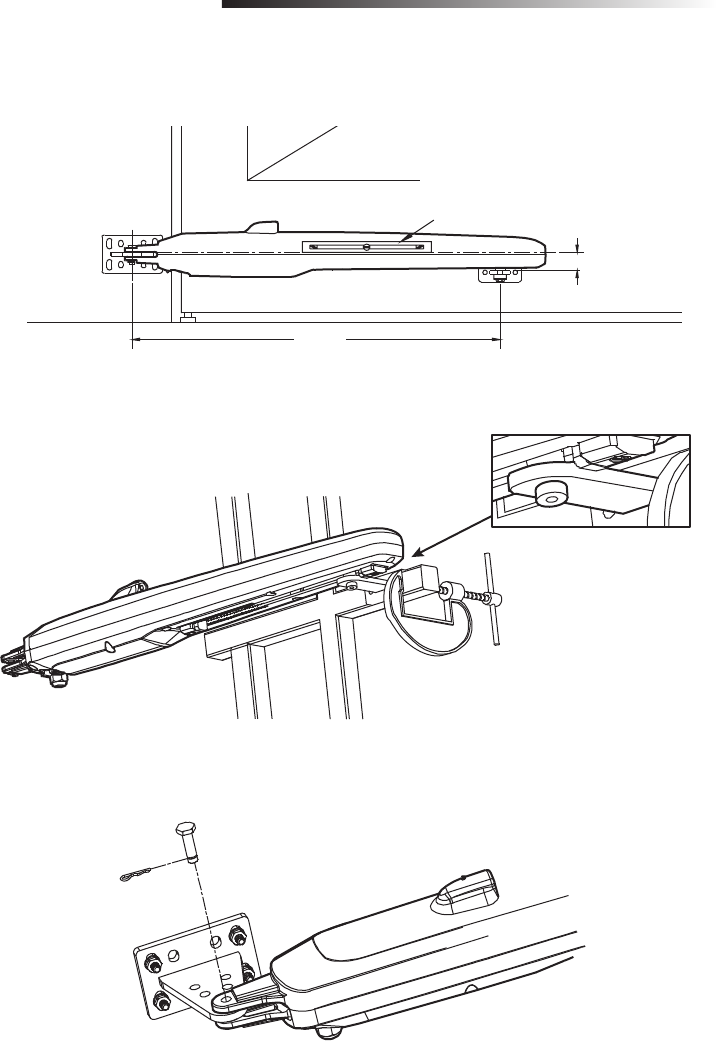
10
730 mm
38 mm
Determine the Position of the Gate Bracket
1. Position the gate bracket 730 mm from the post bracket and 38 mm lower than the post bracket.
2. Temporarily secure the gate bracket to the gate with a clamp.
3. Align the hole on the operator fork to the post bracket hole. Attach the operator to the post bracket
using the clevis pin and secure with a hairpin clip.
Level ruler
When installing the gate
bracket, the washer
should face downward.
INSTALLATION
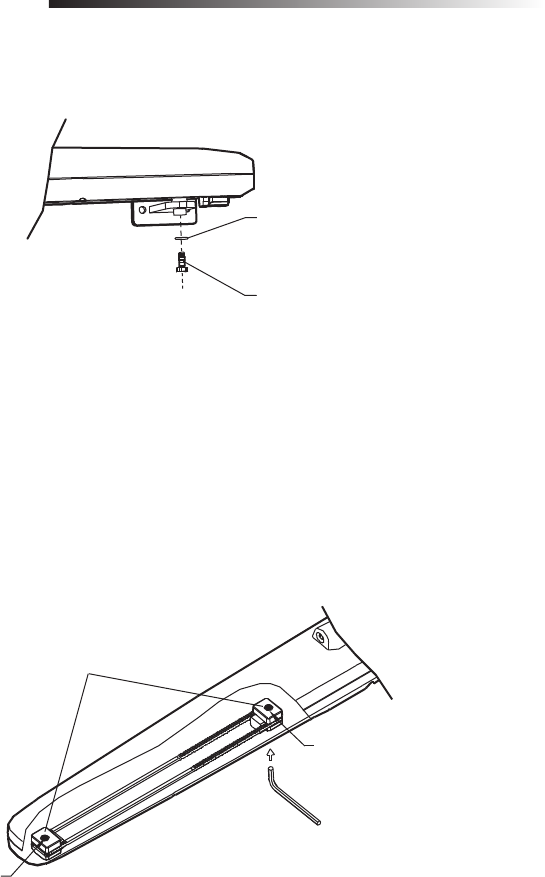
11
4. Secure the operator to the gate bracket using the screw and washer (provided) and tighten.
4. Permanently secure the gate operator to the gate using hardware (not provided) or by welding.
5. Engage the operator with the release key, see page 12.
5. Manually release the operator clutch with the release key, see page 12.
6. Manually open and close the gate. Ensure that the operator does not bind.
Adjust Travel Distance
1. To adjust the gate’s traveling distance, loosen each the adjustment screws using an Allen wrench.
2. Stop the gate in the “full closed” position. Adjust and tighten the close adjustment screw.
3. Stop the gate in the “full open” position. Adjust and tighten the open adjustment screw.
Adjustment Screws
Closing Stop
Opening Stop
Washer
Bolt
INSTALLATION
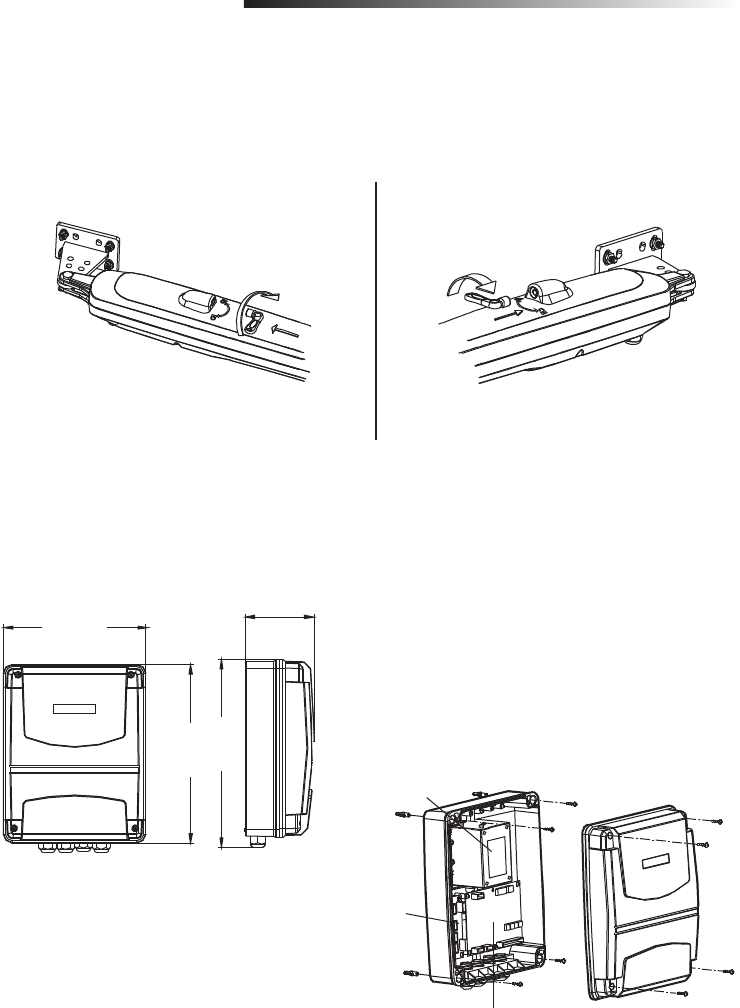
12
To release the clutch: Insert the release key and turn it 180 degrees clockwise. To engage the clutch:
Insert the release key and turn it 180 degrees counterclockwise.
Clutch Release
Release
Engage
Release
Engage
The clutch release for the left operator The clutch release for the right operator
INSTALLATION
1. Install the control box 1.7 m above the ground, see page 7. Use screws and anchors (provided)
to secure the control box.
24V Transformer
24V Control board
Power panel
Install the Control Box
226.5 mm
280 mm
108 mm
296 mm
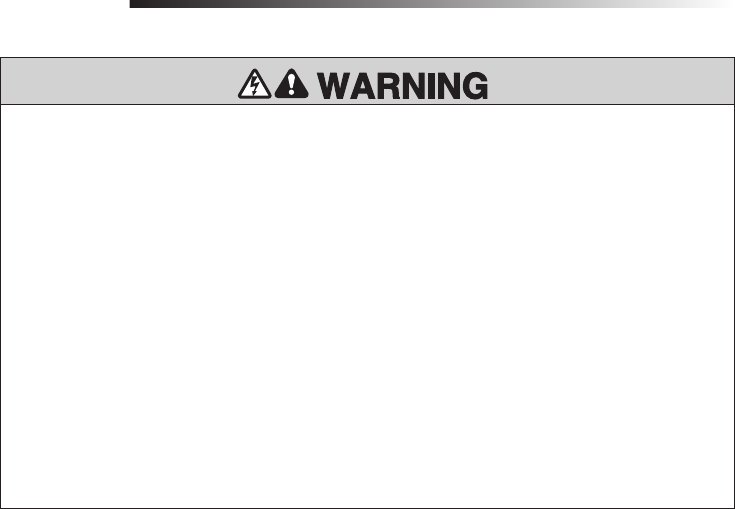
13
To reduce the risk of SEVERE INJURY or DEATH:
• ANY maintenance to the operator or in the area near the operator MUST NOT be
performed until disconnecting the electrical power (AC or solar and battery). Upon
completion of maintenance the area MUST be cleared and secured, at that time the unit
may be returned to service.
• Disconnect power at the fuse box BEFORE proceeding.
NOTE: The operator should be on a separate fused line of adequate capacity.
• ALL electrical connections MUST be made by a qualified individual.
• DO NOT install any wiring or attempt to run the operator without consulting the wiring
diagram.
• ALL power wiring should be on a dedicated circuit and well protected.
• ALL power and control wiring MUST be run in separate conduit.
• BEFORE installing power wiring or control stations be sure to follow all specifications
and warnings described below. Failure to do so may result in SEVERE INJURY to
persons and/or damage to operator.
WIRING
Connect the Gate Operator to the Control Box
NOTE: The operator wired to the MOTO1 terminal will always open fi rst and close last.
1. Select a hole in bottom of the control box to be used for the operator cable.
2. Insert a watertight connector into the bottom of the control box and tighten with nut.
3. Insert the operator cable through the watertight connector.
4. Connect the operator cable wires to the MOTO1 terminal on the board. Blue wire to + and brown
wire to -.
5. Tighten the watertight connector nut.
Connect the Second Gate Operator to the Control Box
NOTE: The operator wired to the MOTO2 terminal will always open last and close fi rst.
Before digging, contact local underground utility locating companies.
1. Trench across driveway to bury the extension cable (not provided). Use PVC conduit to prevent
damage to cables.
2. Insert the extension cable through a watertight connector mounted in the control box.
3. Connect the extension cable wires to the MOTO2 connector on the board. Take note of which wire
is connected to + and which wire is connected to -.
4. Tighten the watertight connector nut.

14
5. Mount a watertight junction box (not provided) that is able to accommodate two watertight
connectors (not provided) within 3 feet (0.9 m) of the second operator.
6. Remove the cover from the watertight junction box and set aside.
7. Route the operator cable through a watertight connector into the junction box.
8. Route the extension cable through a watertight connector into the junction box.
9. Connect the wires from the operator and the extension cable inside the junction box. Connect the
blue wire from the operator to the extension cable wire connected to the + terminal on the board.
Connect the brown wire from the operator to the extension cable wire connected to the - terminal on
the board.
10. Tighten the watertight connector nuts.
11. Reinstall the cover on the watertight junction box.
Voltage Selection
The operator can be wired for either 110-127 Vac or 220-240 Vac through a jumper setting.
NOTE: The factory default setting is 220 Vac.
For 110-127 Vac installations:
1. Turn off the AC power from the main power source circuit breaker.
2. Place the jumper on J3 and the cover on J2 on the control board.
For 220-240 Vac installations:
1. Turn off the AC power from the main power source circuit breaker.
2. Place the jumper on J2 and the cover on J3 on the control board.
Power Wiring
The operator can be wired for either 110-127 Vac or 220-240 Vac.
1. Turn off the AC power from the main power source circuit breaker.
2. Select a hole in bottom of the control box to be used for the incoming AC power.
3. Insert a watertight connector into the bottom of the control box and tighten with nut.
4. Insert the AC power wires through the watertight connector.
5. Connect the “hot” wire to the L terminal on the board.
6. Connect the neutral wire to the N terminal on the board.
7. Tighten the watertight connector nut.
8. Restore power to the control box.
WIRING
To reduce the risk of SEVERE INJURY or DEATH:
• DO NOT TOUCH the unused connections on J2 or J3 as they are energized.
• Replace cover before reconnecting or connecting power.
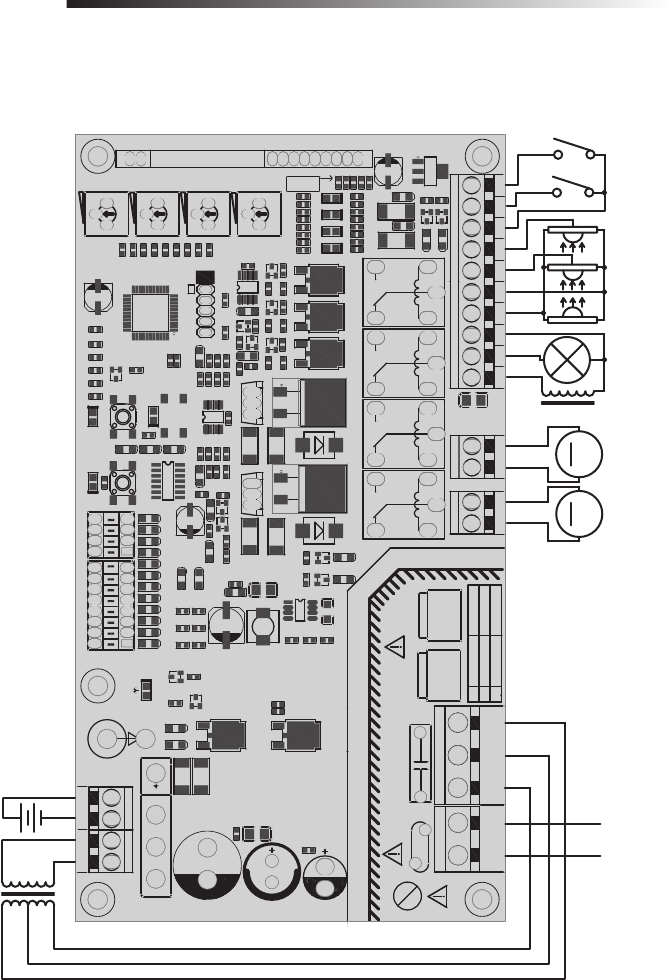
15
WIRING
110-127 Vac
OFF
ON
ON
OFF
J3
J2
230V127VN
POWER LINE
GND
GND
S1COM S2COM
IAD:1
IAD:2
VCCAD
RP3
RP1
RP2
RP4
+
++
-- -
BATAD
+24V
+3.3V
+5V
CHAR
VCC33V
Pb
ET-LA350-R NO.06 2013.9.20
4
3
21
87654321
OFF
ON
-BATTERY+24V AC IN
Charging
+MOTO2- Gate1Gate2
GNDIR2IR1GND
IR.V+
GND
DC.L+Lock+
+MOTO1-
Transformer In
NL
SBC
LEARN
FORCE
RV LV
TIMER
SBC1SBC
IR2IR1
220-240 Vac
Indicator
J3
J2
R78
R77
R80
IC6
VT2-B
VT1-B
Q18
RP3
C30
D33
SW1
D8
R75
R72
R70
R73
R71
R68
Q15
Q17
Q14
LED2
LED3
LED1
SW3
C32
C1
C2
C5
C6
C7
C8
C9
C10
C11
C12
C13
C14
C17
C19
C20
C21
C22
C23
C24
C25
C29
C31
C33
C35
C36
C37
C38
C39
C40
C41
C42
C43
CON1CON2
CON5
CON6
CON7
D1
D2
D3
D4
D5
D6
D7 D9
D10
D11
D12
D13
D14
D15
D16
D17
D18
D19
D20
D21
D22
D23
D24
D25
D26
D27
D36
D29
D30
D31
D32
D34
D35
DB1
DZ2
DZ1
IC1
IC2
IC3
IC4
IC5
J1
K1
K2
K3
K4
L1
LED4
LED5
LED6
LED7
LED8
Q1
Q2 Q3
Q4
Q5
Q6
Q7 Q8
Q9
Q12
Q11
Q13
Q16
Q19
R1
R2
R3
R4
R5
R6
R7
R8
R9
R10
R11
R12
R13
R14
R15
R16
R17
R18
R19 R20
R21
R22
R23
R24
R25
R26
R27
R28
R29
R30
R31
R32
R33
R34
R35
R36
R37
R38
R39 R40
R41
R43
R44
R45
R46
R47
R48
R49
R50
R51
R52
R53
R54
R55
R56
R57 R58
R59
R60
R62
R61
R64
R63
R65
R66 R67
R69
R74
R76
RF1
RP1
RP2
RP4
S1 S2
U1
VT1
VT2
C18
CON4
RV1
CON3
DZ3
R100
1
1
MM
LN
POWER IN
24V DC Motor LOCK DC Lamp
IR TX IR RX1,2
Gate1,2
24V Battery
24V Transformer
Brown
Blue
Brown
Blue
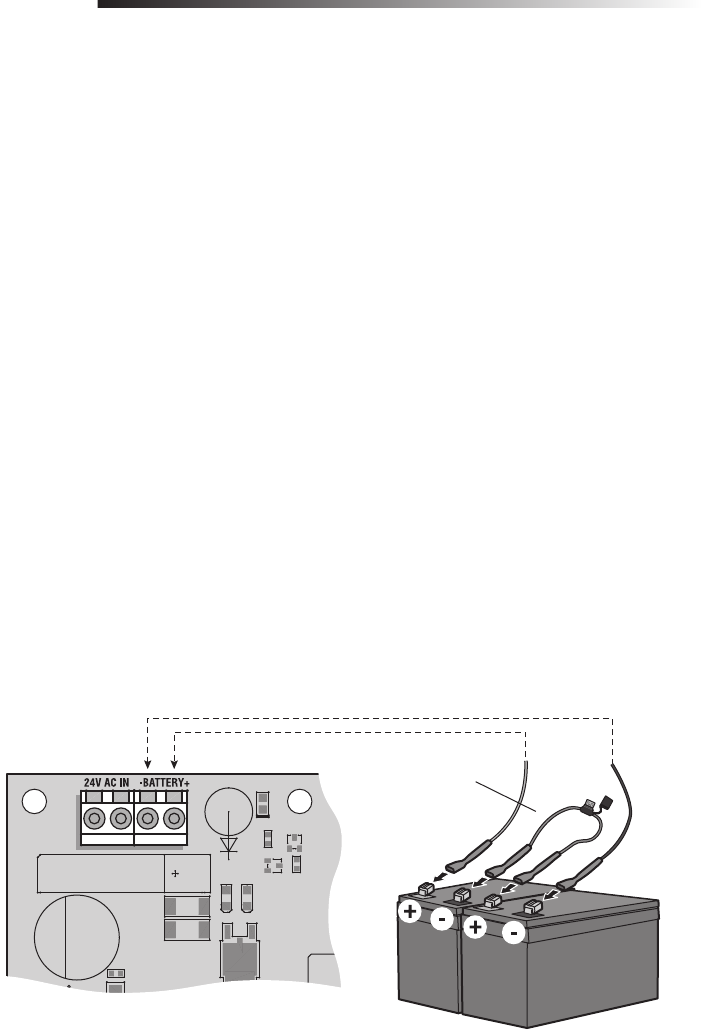
16
WIRING
CONTROL BOARD Jumper with
10A/250V
in-line fuse
(not supplied)
Connect a Battery Backup to the Control Box (Optional)
The batteries are charged in the circuit by the integrated transformer.
Recommended items for a battery backup application (not provided):
• Two 12V 4Ah batteries (McNair Model RB-FM-12V-4AH)
• Battery box (Attwood Model 9069-1)
• 3 x 18 AWG (1.00 mm) VM-1 105°C 600V, 1 wire must have a 10A/250V in-line fuse
1. Disconnect/turn OFF AC power to the operator.
2. Select a hole in the bottom of the control box to be used for the battery backup cable (not
provided).
3. Insert a watertight connector (not provided) into the bottom of the control box and tighten with
nut.
4. Insert the battery cable through the watertight connector mounted in the bottom of the control box.
5. Connect the battery cable to the BATTERY terminal on the control board.
6. Tighten the watertight connector nut.
7. Install battery box in desired location (no further than 10’ away).
9. Place the batteries in the battery box.
10. Connect a jumper with an in-line fuse between the positive (+) terminal on one battery and the
negative (-) terminal on the other battery.
11. Connect the positive battery cable wire to the positive (+) terminal on the battery.
12. Connect the negative battery cable wire to the negative (-) terminal on the other battery.
13. Reconnect/turn ON AC power to the operator.
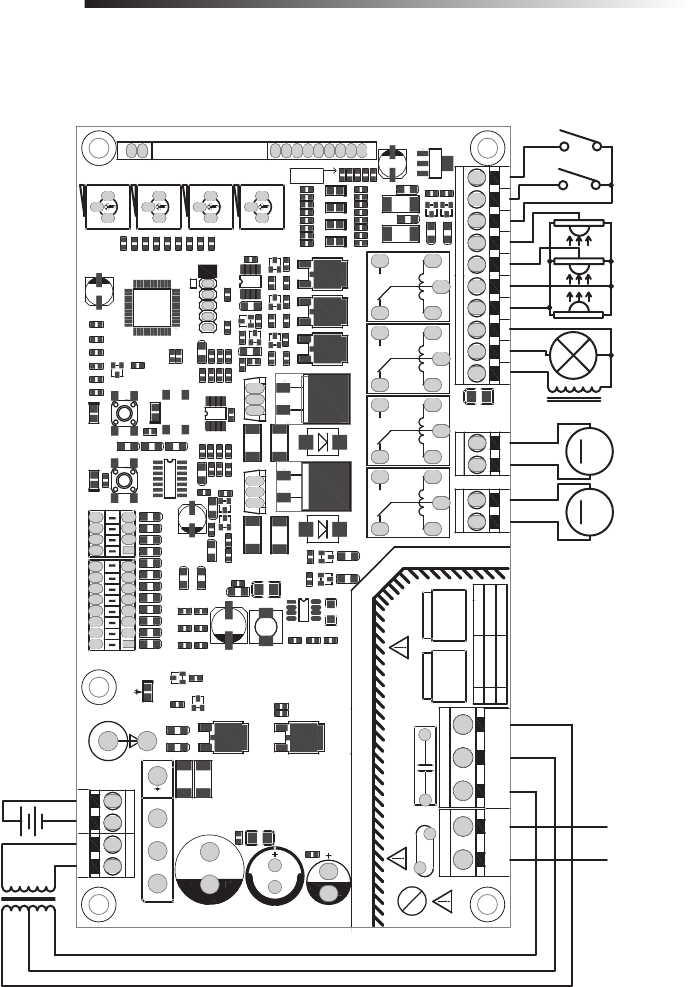
17
110-127 Vac
OFF
ON
ON
OFF
J3
J2
230V127VN
POWER LINE
GND
GND
S1COM S2COM
IAD:1
IAD:2
VCCAD
RP3
RP1
RP2
RP4
+
++
-- -
BATAD
+24V
+3.3V
+5V
CHAR
VCC33V
Pb
ET-LA350-R NO.06 2013.9.20
4
3
21
87654321
OFF
ON
-BATTERY+24V AC IN
Charging
+MOTO2-
Gate1Gate2
GNDIR2IR1GND
IR.V+
GND
DC.L+Lock+
+MOTO1-
Transformer In
NL
SBC
LEARN
FORCE
RV LV
TIMER
SBC1SBC
IR2IR1
220-240 Vac
Indicator
J3
J2
R78
R77
R80
IC6
VT2-B
VT1-B
Q18
RP3
C30
D33
SW1
D8
R75
R72
R70
R73
R71
R68
Q15
Q17
Q14
LED2
LED3
LED1
SW3
C32
C1
C2
C5
C6
C7
C8
C9
C10
C11
C12
C13
C14
C17
C19
C20
C21
C22
C23
C24
C25
C29
C31
C33
C35
C36
C37
C38
C39
C40
C41
C42
C43
CON1CON2
CON5
CON6
CON7
D1
D2
D3
D4
D5
D6
D7 D9
D10
D11
D12
D13
D14
D15
D16
D17
D18
D19
D20
D21
D22
D23
D24
D25
D26
D27
D36
D29
D30
D31
D32
D34
D35
DB1
DZ2
DZ1
IC1
IC2
IC3
IC4
IC5
J1
K1
K2
K3
K4
L1
LED4
LED5
LED6
LED7
LED8
Q1
Q2 Q3
Q4
Q5
Q6
Q7 Q8
Q9
Q12
Q11
Q13
Q16
Q19
R1
R2
R3
R4
R5
R6
R7
R8
R9
R10
R11
R12
R13
R14
R15
R16
R17
R18
R19 R20
R21
R22
R23
R24
R25
R26
R27
R28
R29
R30
R31
R32
R33
R34
R35
R36
R37
R38
R39 R40
R41
R43
R44
R45
R46
R47
R48
R49
R50
R51
R52
R53
R54
R55
R56
R57 R58
R59
R60
R62
R61
R64
R63
R65
R66 R67
R69
R74
R76
RF1
RP1
RP2
RP4
S1 S2
U1
VT1
VT2
C18
CON4
RV1
CON3
DZ3
R100
1
1
MM
LN
POWER IN
24V DC Motor LOCK DC Lamp
IR TX IR RX1,2 Gate1,2
24V Battery
24V Transformer
Brown
Blue
Brown
Blue
WIRING
Wiring Diagram
SBC is an open/close command for a single gate.
NOTE: SBC is also used for the travel limit setting
in conjunction with the S1 No. 8 in the ON position.

18
1. Release the clutch on both operators with the release key. Open both gates completely, then engage
the clutches.
2. Set DIP switch S1 No. 8 to ON position.
3. Press button on the control board, both
gate leaves will close completely.
4. Press button again, both gate leaves will open completely.
5. Set DIP switch S1 No. 8 to OFF position.
ON
OFF
1 2 3 4 5 6 7 8
S1
SBC
SBC
TRAVEL LIMIT SETTINGS
PROGRAMMING
NOTICE: Operation is subject to the following two conditions: (1) this device may not cause harmful interference, and (2) this device must
accept any interference received, including interference that may cause undesired operation.
Any changes or modifi cations not expressly approved by the party responsible for this product could void the user’s authority to operate the
equipment.
This device is designed to provide reasonable protection against harmful interference in a residential installation. This equipment generates,
uses and can radiate radio frequency energy and, if not installed and used in accordance with the instructions, may cause harmful interference
to radio communications. However, there is no guarantee that interference will not occur in a particular installation. If this equipment
does cause harmful interference to radio or television reception, which can be determined by turning the equipment off and on, the user is
encouraged to:
- Connect the equipment into an outlet on a circuit different from that to which the receiver is connected.
- Consult the dealer or an experienced radio/TV technician for help.
Program Remote Control
1. Press and release the LEARN button , LED1 will light.
2. Press the desired button on the remote control to program it to the operator.
The operator will automatically exit learn mode (LED1 will fl ash and go out) if programming is
successful. To program additional Security✚ 2.0™ remote controls or remote control buttons, repeat
the programming steps above. Press the LEARN button a second time to exit programming at any time.
LEARN
Erase All Codes
1. Press and hold the LEARN button , LED1 will light.
2. Hold the LEARN button for approximately 6 seconds. LED1 will go out and all remote control codes
are now erased.
LEARN
The antenna(s) used for this must be installed to provide a separation distance of at least 20 cm from all persons and must not be collocated
The antenna(s) used for this must be installed to provide a separation distance of at least 20 cmfrom all persons and must not be collocated or operating
or operating in conjunction with any other antenna or transmitter, except in accordance with FCC multi-transmitter product procedures.

19
PROGRAMMING
LiftMaster® Internet Gateway
To program the operator to the LiftMaster® Internet Gateway:
1. Connect the Ethernet cable to the LiftMaster® Internet Gateway and the router.
2. Connect power to the LiftMaster® Internet Gateway.
3. Create an online account by visiting www.myliftmaster.com.
4. Register the LiftMaster® Internet Gateway.
5. Use an internet enabled computer or smartphone to add devices. The LiftMaster® Internet Gateway
will stay in learn mode for three minutes.
6. Press the LEARN button on the operator (LED1 will light as it enters learn mode). The LiftMaster®
Internet Gateway will pair to the operator if it is within range and LED1 will fl ash and go out if
programming is successful.
Erase a LiftMaster® Internet Gateway
1. Press and hold the LEARN button , LED1 will light.
2. Hold the LEARN button for approximately 6 seconds. LED1 will go out and all remote control codes
are now erased.
3. Press and hold the LEARN button a second time, LED1 will light again.
4. Hold the LEARN button for approximately 6 seconds. LED1 will go out and all gateways are now
erased.
LEARN
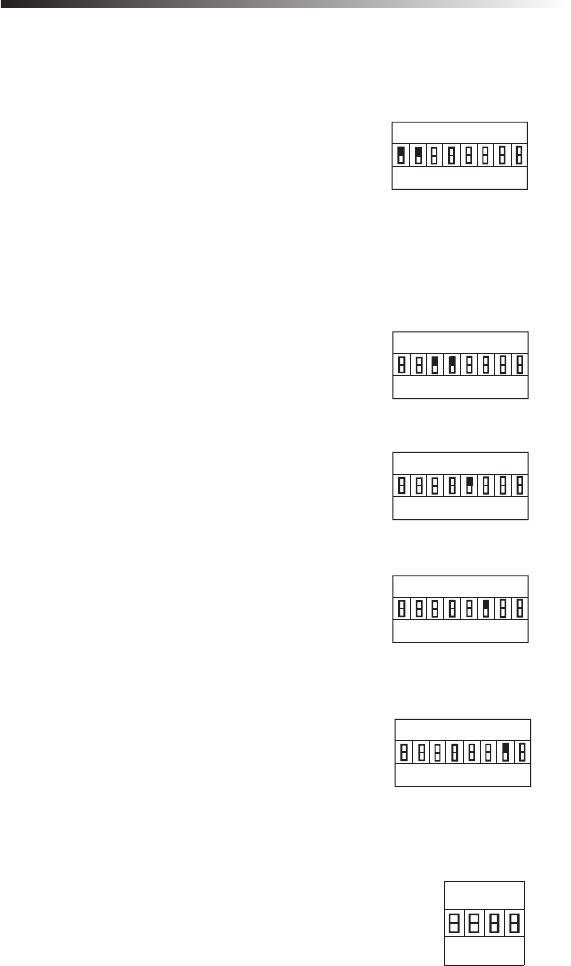
20
Opening/Closing Delay Time Setting
Factory default is set at 2 seconds.
The Open/Closing Delay times can be individually set
from 1-4 seconds.
Opening Delay:
1 OFF and 2 OFF = 1 second
1 ON and 2 OFF = 2 seconds
1 OFF and 2 ON = 3 seconds
1 ON and 2 ON = 4 seconds
The minimum delay time is 1 second.
Closing Delay:
3 OFF and 4 OFF = 1 second
3 ON and 4 OFF = 2 seconds
3 OFF and 4 ON = 3 seconds
3 ON and 4 ON = 4 seconds
The minimum delay time is 1 second.
Single Gate Leaf Operation Setting
5 ON = Only MOTO1 operator is available.
5 OFF = Both MOTO1 and MOTO2 operators are available.
Operation Mode Setting
6 ON = The operation mode is :
OPEN-STOP-CLOSE-OPEN
6 OFF = The operation mode is:
OPEN-STOP-CLOSE-STOP-OPEN
Auto Close Time Setting
Factory default for this function is OFF. The time can be set
from 0-105 seconds.
1 = 15s 2 = 30s 3 = 60s
If all the DIP switches are set to the ON position, the auto
closing time is 105 seconds. If all the DIP switches are set
to the OFF position, the gate leaf will not close automatically.
ON
OFF
1 2 3 4 5 6 7 8
S1
Opening Delay set for 4 seconds
SETTINGS
MOTO1 only
OPEN - STOP - CLOSE - OPEN
ON
OFF
S2
1 2 3 4
ON
OFF
1 2 3 4 5 6 7 8
S1
ON
OFF
1 2 3 4 5 6 7 8
S1
ON
OFF
1 2 3 4 5 6 7 8
S1
ON
OFF
1 2 3 4 5 6 7 8
S1
Closing Delay set for 4 seconds

21
Force Adjustment
Turn the FORCE button clockwise to make the driving
force of the gate stronger. Turn the FORCE button
counterclockwise to make the driving force of the gate
weaker.
Soft Start and Stop Speed Setting
Turn the LV button clockwise to increase the speed.
Turn the LV button counterclockwise to decrease the
speed.
Moving Speed Setting
Turn RV button clockwise to increase the speed of the
gate. Turn the RV button counterclockwise to decrease
the speed of the gate.
Operating Time Setting
Turn the TIMER button clockwise for longer operating
time. Turn TIMER button counterclockwise, for shorter
operating time. The time can be set from a maximum of
60 seconds to a minimum of 30 seconds.
WeakerStronger
LVRV FORCETIMER
LVRV FORCETIMER
LVRV FORCETIMER
SlowerFaster
SlowerFaster
SETTINGS
Shorter
Longer
LVRV FORCETIMER

22
Maglock (Optional)
The LOCK and GND connectors on the board are for the MG1300 MAGLOCK
(24V/250 mA). When the maglock is connected, the lock will disengage before the gate opens.
Flashing Light (Optional)
The DCL and GND connectors on the board are for the FA42LM fl ashing light. The fl ashing light will
turn on before the gate opens.
The Photoelectric Sensor (Optional) Connection
The connection for the photoelectric sensor is a normal closed. If the operator is installed without
photoelectric sensors, connect the IR1 terminal to the GND terminal with a jumper and connect the
IR2 terminal to the GND terminal with a jumper, otherwise the operator will not function properly.
The jumpers are installed from the factory. If IR1 or IR2 is used, leave the other pair of terminals
connected with a jumper.
When the beam of a photoelectric sensor IR1 is interrupted by obstacles, the gate will stop and
reverse during closing or stop during opening. IR1 LED on the control board will turn off. When
the beam of a photoelectric sensor IR2 is interrupted by obstacles, the gate leaf will stop in either
direction. IR2 LED on the control board will turn off.
SETTINGS

23
OPERATION AND MAINTENANCE
• READ AND FOLLOW ALL INSTRUCTIONS.
• NEVER let children operate or play with gate controls. Keep the remote control away
from children.
• ALWAYS keep people and objects away from the gate. NO ONE SHOULD CROSS THE
PATH OF THE MOVING GATE.
• Test the gate operator monthly. The gate MUST reverse on contact with a rigid object
or stop when an object activates the non-contact sensors. After adjusting the force or
the limit of travel, retest the gate operator. Failure to adjust and retest the gate operator
properly can increase the risk of INJURY or DEATH.
• Use the emergency release ONLY when the gate is not moving.
• KEEP GATES PROPERLY MAINTAINED. Read the owner’s manual. Have a qualified
service person make repairs to gate hardware.
• The entrance/exit is intended for vehicles. Pedestrians should be supplied with a
separate access opening.
• Activate gate ONLY when it can be seen clearly, is properly adjusted and there are no
obstructions to gate travel.
• Locate entrapment protection devices to protect in BOTH the open and close gate
cycles.
• SAVE THESE INSTRUCTIONS.
IMPORTANT SAFETY INSTRUCTIONS
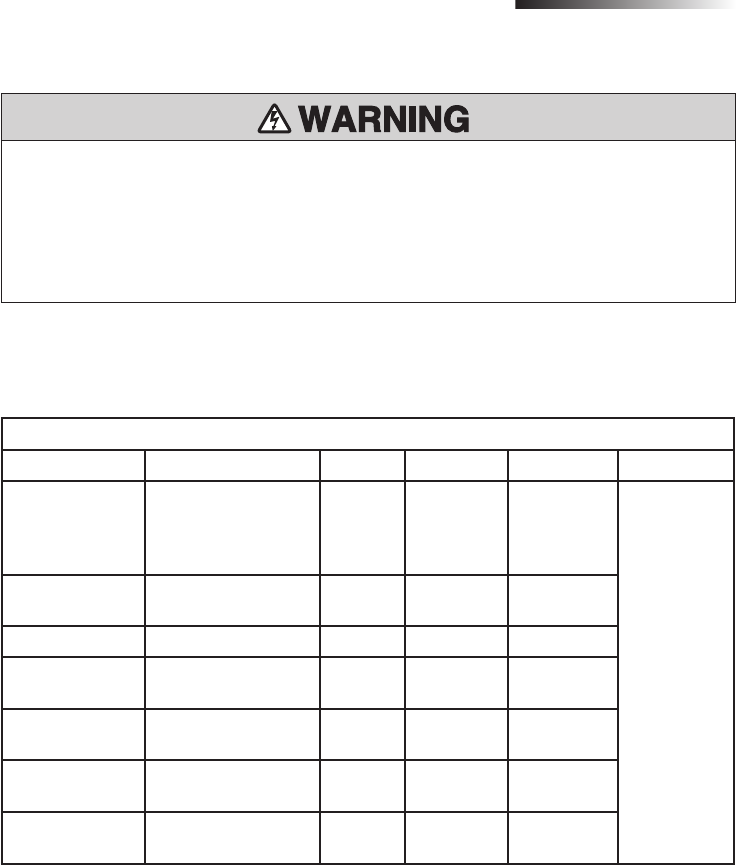
24
To reduce the risk of SEVERE INJURY or DEATH:
• Disconnect ALL power BEFORE performing ANY maintenance.
• ALL maintenance MUST be performed by a LiftMaster® professional.
• ALWAYS wear protective gloves and eye protection when changing the battery or
working around the battery compartment.
Maintenance
OPERATION AND MAINTENANCE
CHECK AT LEAST ONCE EVERY
DESCRIPTION TASK MONTH 3 MONTHS 6 MONTHS 12 MONTHS
External
entrapment
protection
systems
Check for proper
operation •
Complete Check Out
Gate warning
signs Make sure they are
present •
Manual release Check and operate •
Gate Inspect for wear or
damage •
Accessories Check all for proper
operation •
Electrical Inspect all wire
connections •
Total unit Inspect for wear or
damage •
Maintenance Chart

25
OPERATION AND MAINTENANCE
There are different kinds of materials in a gate operator. Some can be recycled, such as aluminum, iron,
plastic, wires etc., not all materials are recyclable.
1. Completely disconnect all power to the operator.
2. Disassemble all the equipment and accessories.
3. Remove the backup battery in the control box and the battery in the remote control.
4. Take out the control board.
5. Recyclable materials should be handled by the local qualifi ed company.
6. Backup battery, battery from remote control and control board, etc. with harmful substances
should be handled by the local qualifi ed company to prevent environmental pollution.
Lead-acid backup battery and some electronic material are harmful substances. In order
not to get the environment polluted, they should be recycled or discarded according to
requirements of the local law regulation.
Recycling

26
Trouble Cause Solution
The operator doesn’t
work. 1. The plug is not securely
connected. 1. Have the power supply connected
securely by a qualifi ed technician.
The operator will not
work from the remote
control.
1. The remote control has not
been programmed.
2. The remote control battery
needs to be replaced.
3. The clutch is disengaged.
1. Program the Remote, see page 18.
2. Replace the battery.
3. Engage the clutch with the release
key.
The remote control
distance is short. The remote control battery
needs to be replaced. Replace with a new battery of the same
type.
The moving speed of
the gate leaf is slow. 1. The gate was not installed
properly.
2. The moving speed of the
operator is not adjusted
properly.
1. Release the operator and move the
gate leaf by hand to see if it can move
smoothly.
2. Set the moving speed, see Moving
Speed Setting on page 21.
The gate leaf will
not open or close
completely or it does
not move.
1. The photoelectric sensor is
shielded.
2. The operating time of the
operator is not adjusted
properly.
1. Check and make sure the
photoelectric sensor is not shielded.
2. Set the operating time, see Operating
Time Setting on page 21.
The gate leaf will not
close automatically. 1. The auto closing function is
set OFF.
2. The operator wires are not
connected properly.
1. Set the auto closing time, see Auto
Closing Setting on page 20.
2. Connect the wires, see Wiring
Diagram on page 17.
TROUBLESHOOTING
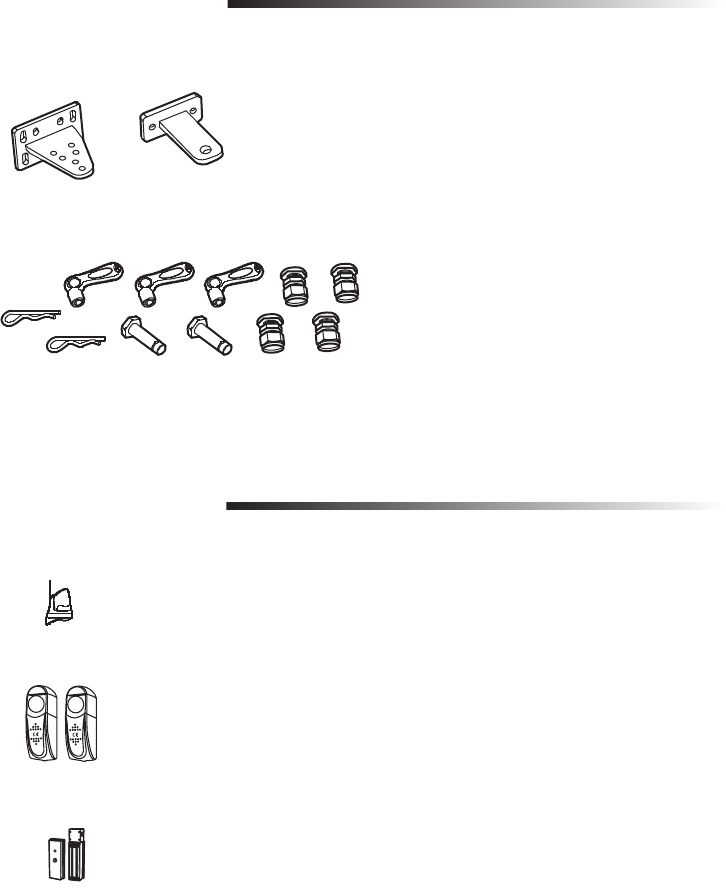
27
SERVICE KITS
K80-36930 LA350 Bracket Kit
K80-36931 LA350 Hardware Kit
FA42LM Flashing Light
FA31LM Photoelectric Sensor
MG1300 Maglock
ACCESSORIES
For support contact:
americalatina@chamberlain.com
K2A1832 LA350 Control Board
FA70LM LA350 Control Box
TX4UNI 4 Channel EVO Transmitter

28
Notes:
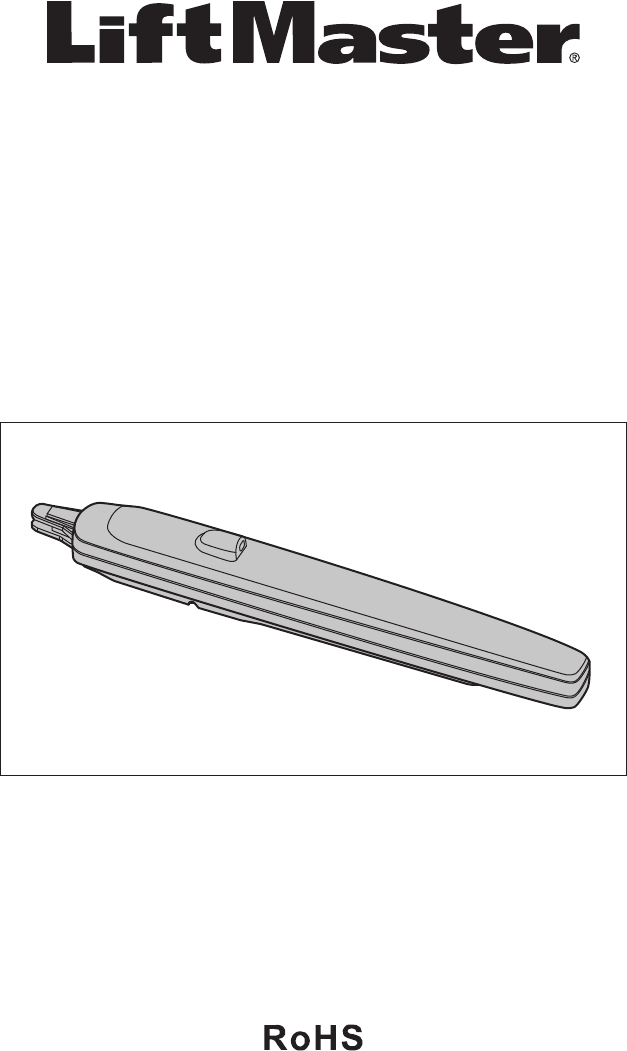
LEA ATENTAMENTE EL MANUAL ANTES DE PROCEDER CON LA INSTALACIÓN Y EL USO
ESTE PRODUCTO DEBE SER INSTALADO POR UN TÉCNICO
PROFESIONAL EN SISTEMAS PARA PORTONES.
LA350
OPERADOR DE PORTÓN BATIENTE
MANUAL DE INSTALACIÓN

2
CONTENIDO
SEGURIDAD ......................................................................................................................................... 3-5
INTRODUCCIÓN
Especificaciones técnicas .........................................................................................................................6
Contenido de la caja .................................................................................................................................6
Herramientas necesarias ..........................................................................................................................7
Vista general del operador de portón y cableado a la caja de control ......................................................7
INSTALACIÓN
Determinar la posición del soporte de columna ......................................................................................8
Dimensiones del operador de portón .......................................................................................................9
Determinar la posición del soporte de portón.................................................................................. 10-11
Regular la distancia de desplazamiento .................................................................................................11
Liberación del embrague .......................................................................................................................12
Instalar la caja de control .......................................................................................................................12
CONEXIONES
Conectar el operador de portón a la caja de control ..............................................................................13
Conectar el segundo operador de portón a la caja de control ...............................................................13
Elección de voltaje .................................................................................................................................14
Conexión de alimentación eléctrica ........................................................................................................14
Conectar a la caja de control la línea de reserva de batería (opcional) ..................................................16
Diagrama de conexiones ........................................................................................................................17
CALIBRACIÓN DEL LÍMITE DE DESPLAZAMIENTO ...............................................................................18
PROGRAMACIÓN
Programar el control remoto .................................................................................................................18
Borrar todos los códigos .......................................................................................................................18
LiftMaster® Internet Gateway .................................................................................................................19
Borrar un LiftMaster® Internet Gateway .................................................................................................19
CONFIGURACIÓN
Retardo de apertura y cierre ..................................................................................................................20
Programación para portón de una sola hoja ..........................................................................................20
Programación del modo de funcionamiento ..........................................................................................20
Cierre automático ...................................................................................................................................20
Regulación de la fuerza ..........................................................................................................................21
Calibración de arranque lento y velocidad de parada .............................................................................21
Calibración de la velocidad de movimiento ............................................................................................21
Calibración del tiempo de funcionamiento .............................................................................................21
Cerradura magnética (opcional) .............................................................................................................22
Luz intermitente (opcional) ....................................................................................................................22
Conexión del sensor fotoeléctrico (opcional) .........................................................................................22
USO Y MANTENIMIENTO ................................................................................................................. 23-25
DIAGNÓSTICO DE FALLAS ....................................................................................................................26
JUEGOS DE REPUESTO .........................................................................................................................27
ACCESORIOS .........................................................................................................................................27
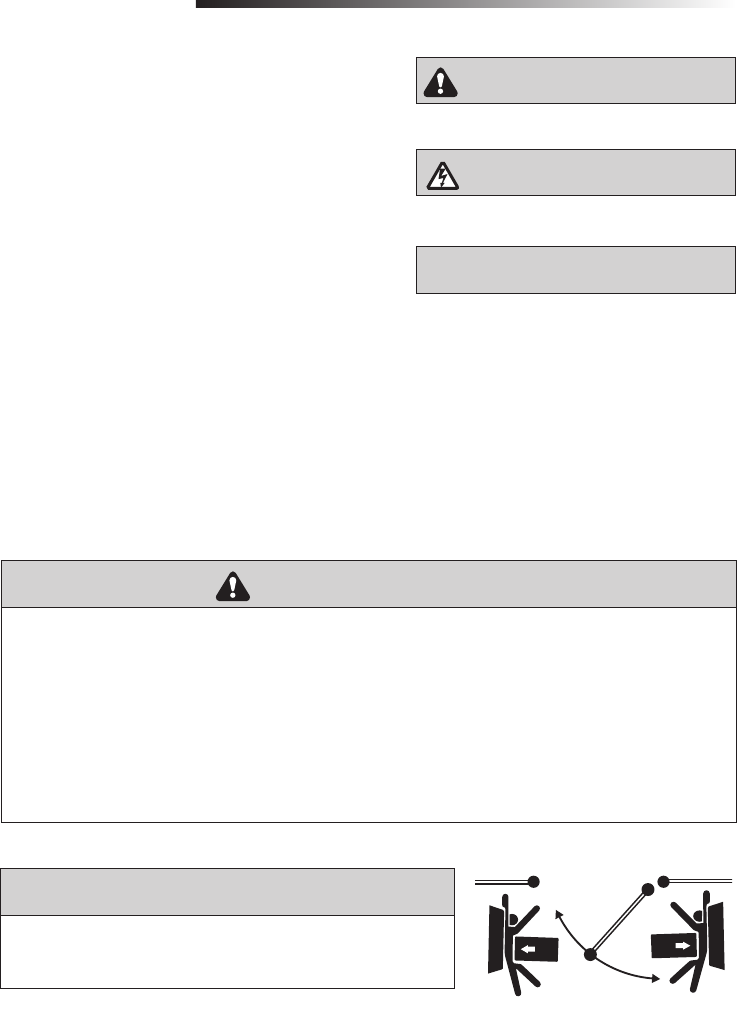
3
PRECAUCIÓN ADVERTENCIA
ADVERTENCIA
ADVERTENCIAADVERTENCIA
PRECAUCIÓN ADVERTENCIA
ADVERTENCIAADVERTENCIA
ADVERTENCIA
PRECAUCIÓNPRECAUCIÓN
ADVERTENCIA
ADVERTENCIA
ADVERTENCIA
MECÁNICA
ELECTRICIDAD
Estas advertencias y/o símbolos de seguridad que
aparecen a lo largo de este manual le alertarán de la
existencia de riesgo de una lesión seria o de muerte si no
se siguen las instrucciones correspondientes. El peligro
puede ser eléctrico (electrocución) o mecánico. Lea
atentamente las advertencias.
Cuando vea esta palabra y/o símbolo de seguridad a lo
largo de este manual le alertará de que existe el riesgo
de dañar el portón y/o el operador del mismo si no
se siguen las instrucciones correspondientes. Léalas
detenidamente.
Medidas de seguridad para portones batientes y de reja ornamental
SEGURIDAD
Para evitar LESIONES GRAVES o la MUERTE por accidentes con el portón en movimiento:
• INSTALAR dispositivos de protección contra atrapamiento por la seguridad de personas que se
acerquen a un portón en movimiento.
• Usar dispositivos de seguridad tanto para apertura como para cierre.
• Instalar protección contra atrapamiento para cubrir los espacios entre el portón y objetos
RÍGIDOS, tales como columnas y postes.
• Un portón batiente NO debe abrirse hacia lugares de acceso público.
• CONSERVAR ESTAS INSTRUCCIONES.
PRECAUCIÓN ADVERTENCIA
ADVERTENCIA
ADVERTENCIAADVERTENCIA
Es recomendable usar cerraduras electrónicas/magnéticas
por seguridad y donde pueda haber vientos fuertes.
PRECAUCIÓNPRECAUCIÓN
ADVERTENCIA
ADVERTENCIA
ADVERTENCIA
NOTA IMPORTANTE:
• ANTES de instalar, usar o reparar el operador, debe leer y comprender totalmente este manual y
seguir todas las instrucciones de seguridad.
• Estas instrucciones destacan temas importantes de seguridad. Estas instrucciones no son de
aplicación general para todos los casos. Como cada instalación tiene sus propias características, la
seguridad y aptitud de funcionamiento del portón es responsabilidad del comprador, del técnico de
instalación y del usuario fi nal.
• Conserve estas instrucciones.

4
Para reducir el riesgo de LESIONES GRAVES o la MUERTE por defectos de instalación:
1. Los sistemas de control de paso vehicular son prácticos y seguros. Los sistemas operadores de
portones tienen varios componentes. La unidad operadora es uno de esos componentes. Cada
sistema está diseñado específicamente para una aplicación individual.
2. Los diseñadores, instaladores y usuarios del sistema de operación deben tener en cuenta los
posibles peligros relacionados con cada aplicación individual. Los sistemas incorrectamente
diseñados, instalados o mantenidos pueden crear riesgos para el usuario y los transeúntes. El
diseño y la instalación de los sistemas abre-puertas deben minimizar los potenciales peligros
para el público.
3. El operador puede crear fuerzas de magnitud como componente del sistema. Por lo tanto, todo
diseño debe incluir funciones de seguridad. Entre estas funciones de seguridad pueden
mencionarse:
• Bordes especiales • Protección de rodillos • Sensores fotoeléctricos
• Mallas • Columnas • Carteles de instrucciones y seguridad
4. Instalar el operador sólo cuando:
a. El operador es apropiado para la construcción y el uso de la puerta.
b. Todas las aberturas de un portón batiente horizontal estén protegidas o cubiertas por una
malla desde la parte inferior hasta un mínimo de 1.2 m sobre el nivel del suelo para impedir
que una esfera de 6 cm de diámetro atraviese cualquiera de las aberturas, y en aquella parte
de la cerca adyacente que cubra el portón en posición abierta.
c. Se hayan eliminado o protegido todos los puntos de presión expuestos, y se hayan colocado
protecciones para los rodillos que quedan expuestos.
5. El operador debe usarse únicamente con portones para paso de vehículos. Los peatones deben
ser provistos de una vía de acceso independiente.
6. El portón debe instalarse en un lugar de modo que haya suficiente espacio libre entre el portón y
las estructuras adyacentes al abrirse y cerrarse, para reducir el riesgo de quedar atrapado. Los
portones batientes no deben abrirse hacia espacios de acceso público.
7. Antes de instalar el operador, el portón debe estar instalado y debe moverse libremente en
ambas direcciones.
8. Los controles deben estar alejados del portón, a una distancia que impida que el usuario entre
en contacto con el portón cuando usa los controles.
PRECAUCIÓN ADVERTENCIA
ADVERTENCIA
ADVERTENCIAADVERTENCIA
SEGURIDAD
INFORMACIÓN IMPORTANTE DE SEGURIDAD

5
SEGURIDAD
9. Para un operador de portón con sensor sin contacto:
a. Consultar el manual del instrucciones para determinar el lugar de montaje del sensor para
cada tipo de aplicación.
b. Tomar precauciones para reducir el riesgo de tropiezos cuando un vehículo activa un sensor
cuando el portón todavía está en movimiento.
c. Donde haya riesgo de atrapamiento u obstrucción, tal como el perímetro de movimiento del
portón o la barrera, es necesario instalar uno o más sensores sin contacto.
10. Para un operador con sensor de contacto, tal como un sensor de borde:
a. El montaje y las conexiones del sensor de contacto con el operador deben ubicarse de
manera que haya riesgo de daños accidentales.
b. Un sensor de contacto inalámbrico, como el que transmite señales de frecuencia de radio
(RF) al operador del portón para las funciones de protección de atrapamiento estará
ubicados donde no esté obstruidas la transmisión de las señales. Un sensor de contacto
inalámbrico debe funcionar según las condiciones estipuladas de uso.
c. En un portón batiente deben instalarse sensores de contacto del lado interno y externo del
borde. Además, si el borde inferior de un portón batiente está a más de 15 cm sobre el nivel
del suelo en cualquier punto de su arco de desplazamiento, deben instalarse uno o más
sensores de contacto en el borde inferior.
INFORMACIÓN IMPORTANTE DE SEGURIDAD
PRECAUCIÓN ADVERTENCIA
ADVERTENCIA
ADVERTENCIAADVERTENCIA
IMPORTANTE: La función MyQ y sus accesorios no están permitidos para uso en los países de Perú y
Chile.
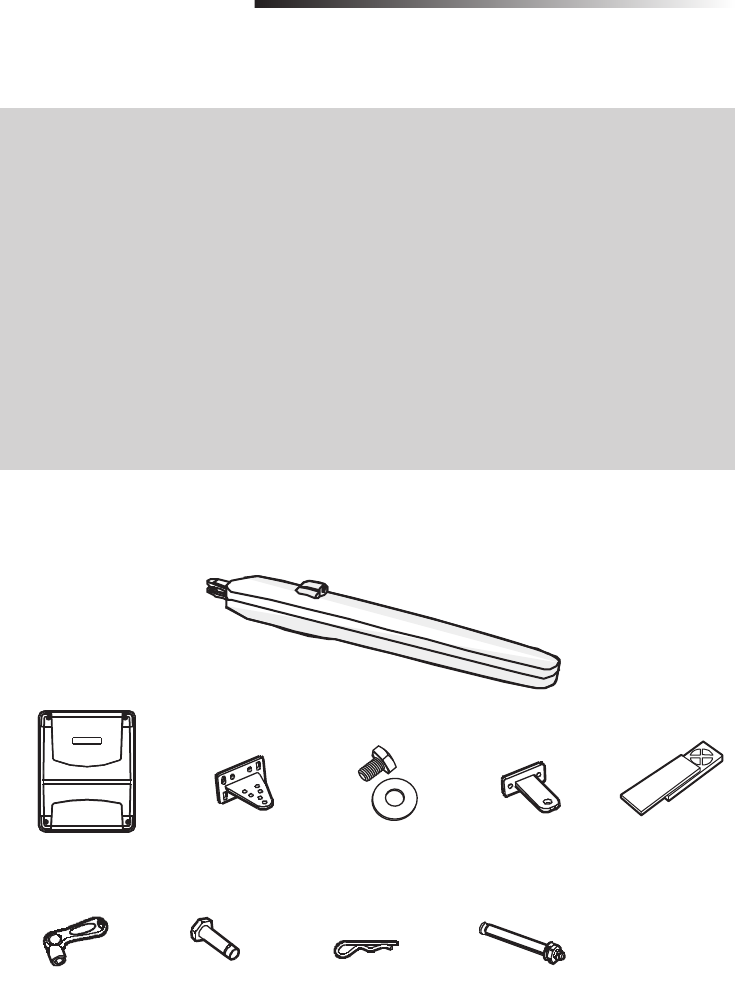
6
Especificaciones técnicas
INTRODUCCIÓN
Contenido de la caja
Alimentación principal de CA: 110-127 VCA / 220-240VCA; 50/60 Hz
Voltaje del motor: 24 VCC
Potencia: 100 W
Rango de temperatura ambiente: -25 ~ +50 ˚C
Peso máximo de una hoja del portón: 350 Kg
Ancho máximo de una hoja del portón: 1.8 m, 2.5 m (con cerradura eléctrica)
Ángulo máximo de apertura: 120˚
Clasifi cación de protección: IP 44
Distancia máxima de desplazamiento: 350 mm
Ciclos diarios de funcionamiento: Máximo de 50 ciclos por día
Peso del operador: 6 Kg
Manual de
instalación
(no mostrado)
Control remoto (2)Soporte de
montaje para
columna (2)
Soporte de
montaje para
portón (2)
Arandela y perno
(fi jados al brazo)
Caja de control
Llave de acople (3) Chaveta pasante (2)Pasador (2) Tornillos M8x60 (8)
Operador
Modelo LA350 (2)
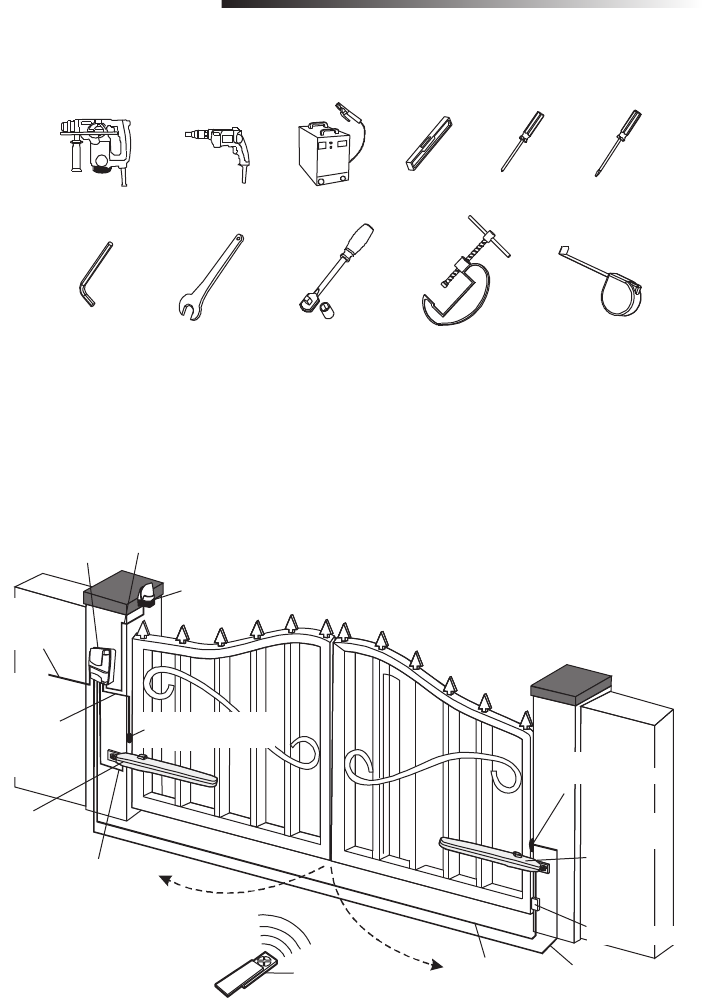
7
Vista general del operador de portón y cableado a la caja de control
Herramientas necesarias
LA350
Operador de
portón con cable
de 1000 mm
Cable de
sensor fotoeléctrico:
4 X 0.5 mm2 o
2 X 0.5 mm2 (opcional)
Cable de
extensión por
MOTO2:
2 X 1.0 mm2
(no suministrada)
Cable de luz intermitente:
2 X 1 mm2
(opcional)
Control
remoto
FA42LM
Luz intermitente
(opcional)
FA70LM
Caja de
control
Cable de
alimentación:
2 X 1.5 mm2
Cables de
MOTO1
Y MOTO2
2 X 1.0 mm2
FA31LM Sensor
fotoeléctrico (opcional)
Cable de
sensor
fotoeléctrico:
4 X 0.5 mm2
o 2 X 0.5 mm2
(opcional)
Caja de
empalmes
(no suministrada)
FA31LM Sensor
fotoeléctrico (opcional)
LA350
Operador de
portón con
cable de
1000 mm
Los cables deben cumplir con todos los códigos locales y nacionales para el uso al aire libre.
INTRODUCCIÓN
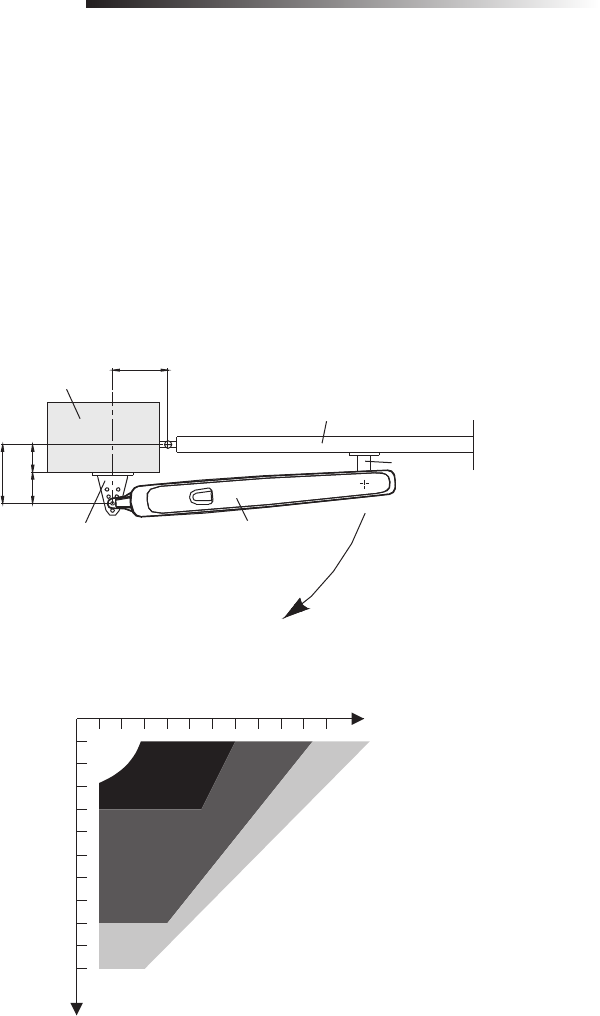
8
Determinar la posición del soporte de columna
1. Medir la distancia C.
2. La distancia D dependerá del lugar de montaje del soporte de columna.
3. La distancia A es la suma de C y D.
4. La distancia B dependerá de A y del ángulo máximo de apertura del portón. Consultar
la Tabla 1 a continuación.
NOTA: Para obtener óptimo funcionamiento mecánico, la distancia B debe ser cercana o igual a la
distancia A.
5. Con los valores de A y B, confi rmar en la Tabla 1 la posición de montaje del soporte de columna.
A
B
D
C
Portón
Operador de portón
Soporte de columna
Soporte de
portón
Columna del portón
100
110
120
130
140
150
160
170
180
190
200
100
110
120
130
140
150
160
170
180
190
200
Máx. 120˚
Máx. 110˚
Máx. 100˚
Máx. 90˚
A
B
Unidad = mm
Tabla 1 Apertura máxima del portón
INSTALACIÓN
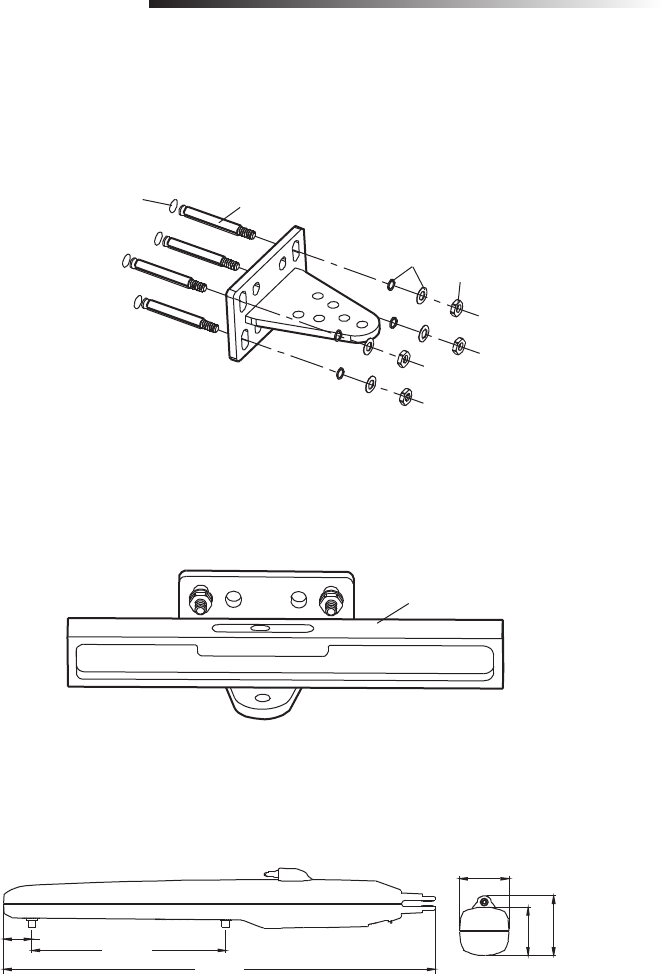
9
6. Usando el mismo soporte como plantilla, marcar los agujeros de montaje.
7. Fijar el soporte de columna con tornillos M8x60, arandelas y tuercas.
8. Las ranuras del soporte ayudan a alinearlo durante el montaje. Ajustar las tuercas una vez que el
soporte de columna esté bien alineado.
Nivel
Agujero Tornillo M8x60
Arandelas
Tuerca
55 mm
115.3 mm
93.5 mm
95 mm
835 mm
350 mm
Dimensiones del operador de portón
INSTALACIÓN
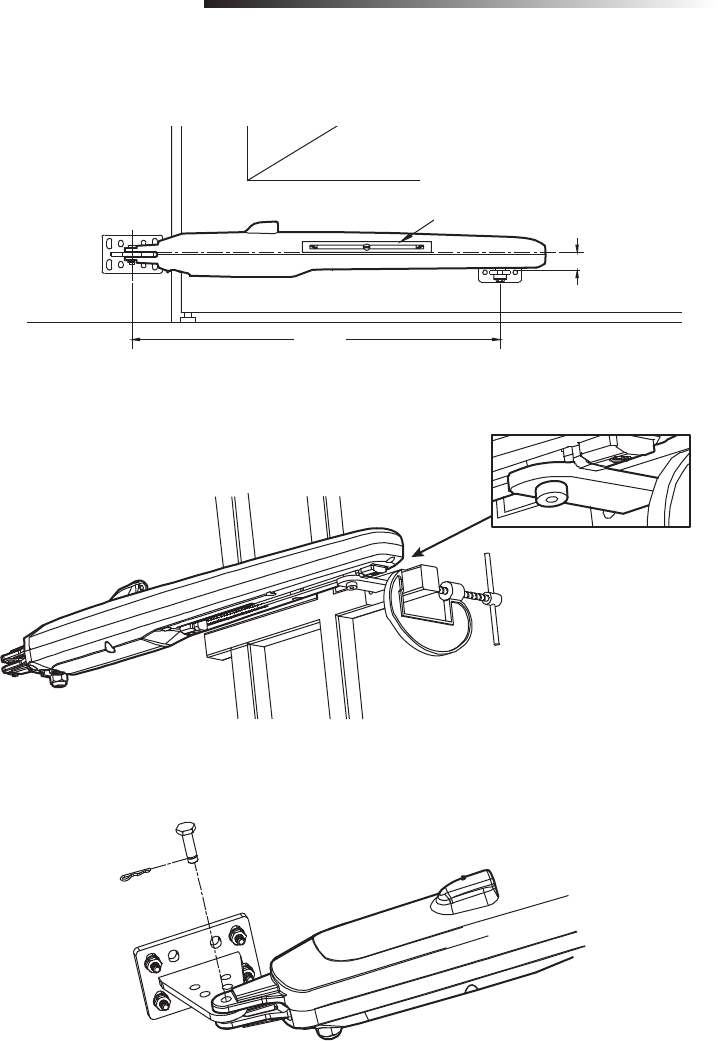
10
730 mm
38 mm
Determinar la posición del soporte del portón
1. Colocar el soporte del portón a 730 mm del soporte de columna y a 38 mm por debajo del mismo.
2. Fijar provisoriamente el soporte del portón con una abrazadera.
3. Alinear el orifi cio de la horquilla del operador con el orifi cio del soporte de columna. Fijar el
operador al soporte de columna con el pasador y la chaveta pasante.
Nivel
Para instalar el soporte del
portón, la arandela debe
quedar orientada hacia abajo.
INSTALACIÓN
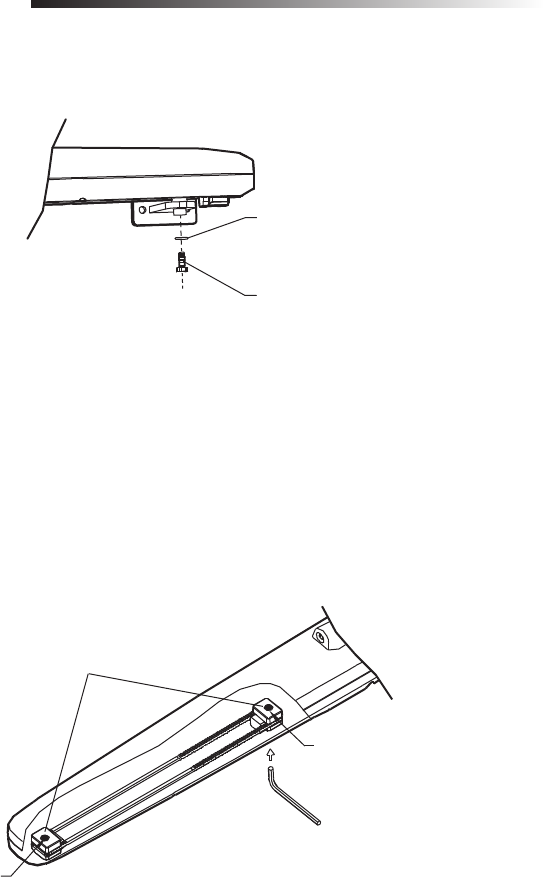
11
4. Fijar y ajustar con tornillo y arandela (suministrados) el operador al soporte del portón.
4. Montar la unidad operadora en el portón con ferretería o soldadura (accesorios de fi jación no
suministrados).
5. Acoplar el embrague del operador con la llave correspondiente. Véase la página 12.
5. Liberar manualmente el embrague del operador con la llave correspondiente. Véase la página 12.
6. Abrir y cerrar el portón manualmente. Verifi car que el portón no se atasque.
Regular la distancia de desplazamiento
1. Para regular la distancia de desplazamiento afl ojar cada tornillo de regulación con una llave Allen.
2. Detener el portón en la posición de totalmente cerrado. Ajustar el tornillo de regulación de cierre.
3. Detener el portón en la posición de totalmente abierto. Ajustar el tornillo de regulación de apertura.
Tornillos de regulación
Tope de cierre
Tope de
apertura
Arandela
Perno
INSTALACIÓN
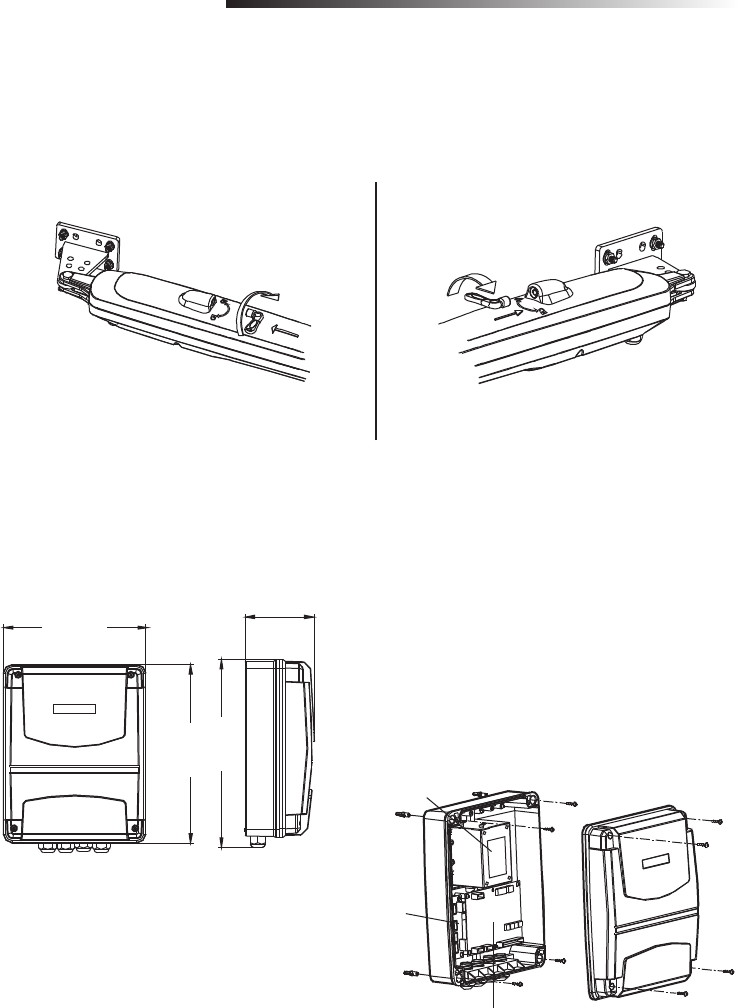
12
Para liberar el embrague: Introducir la llave y hacerla girar 180 grados en sentido horario. Para acoplar
el embrague: Introducir la llave y hacerla girar 180 grados en sentido antihorario.
Liberación del embrague
Liberación
Acople
Liberación
Acople
Liberación del embrague para el operador izquierdo. Liberación del embrague para el operador derecho.
INSTALACIÓN
1. Instalar la caja de control a 1.7 m sobre el nivel de piso. Véase la página 7. Fijar la caja de
control con los tornillos y tarugos suministrados.
Transformador de 24 V
Tarjeta de control de 24 V
Panel de
alimentación
Instalar la caja de control
226.5 mm
280 mm
108 mm
296 mm

13
Para reducir el riesgo de LESIONES GRAVES o la MUERTE:
• No realizar mantenimiento en el operador ni en el área cercana al mismo sin cortar la
alimentación eléctrica (CA, solar y batería). Al terminar el mantenimiento, limpiar y asegurar el
área antes de que el portón vuelva a entrar en servicio.
• Desconectar la alimentación eléctrica en la caja de fusibles ANTES de continuar.
NOTA: La alimentación eléctrica del operador debe originarse en una línea independiente con
fusibles propios.
• Un técnico profesional DEBE realizar la instalación eléctrica.
• NO haga conexiones ni ponga en funcionamiento el operador sin consultar el esquema de
conexiones y cableado.
• La alimentación eléctrica DEBE estar en un circuito independiente y con protección apropiada.
• El cableado de alimentación y de control DEBE estar en conductos separados.
• ANTES de instalar el cableado el alimentación y control verificar que se cumplan las
especificaciones e instrucciones siguientes. Esto es para evitar GRAVES ACCIDENTES LESIVOS y
daños materiales.
PRECAUCIÓN ADVERTENCIA
ADVERTENCIA
ADVERTENCIA
CONEXIONES
Conectar el operador de portón a la caja de control
NOTA: El operador conectado al terminal MOTO1 siempre abrirá primero y cerrará último.
1. Determinar qué orifi cio del fondo del tablero se usará para el cable de la unidad operadora.
2. Introducir el conector hermético en el fondo del tablero y ajustar la tuerca.
3. Pasar el cable del operador por el conector hermético.
4. Conectar los conductores del cable al terminal MOTO1 del tablero. Cable azul al + y marrón al -.
5. Ajustar bien la tuerca del conector pasante.
Conectar el segundo operador de portón a la caja de control
NOTA: El operador conectado al terminal MOTO2 siempre abrirá último y cerrará primero.
Antes de hacer una excavación comunicarse con la compañía local de servicios para determinar la
ubicación de las líneas de servicio.
1. Instalar el cable de extensión (no suministrado) por debajo de la entrada de vehículos. Usar
conducto de PVC para proteger los cables.
2. Pasar el cable de prolongación por un conector hermético en la caja de control.
3. Conectar los conductores del cable al terminal MOTO2 del tablero. Prestar atención a los
conductores que se conecten al positivo y al negativo.

14
4. Ajustar bien la tuerca del conector pasante.
5. Montar una caja de empalmes hermética (no suministrada) apta para dos conectores herméticos
(no suministrados) a una distancia de 0.9 m del segundo operador.
6. Quitar la tapa de la caja de empalmes.
7. Pasar el cable del operador por uno de los conectores herméticos de la caja de empalmes.
8. Pasar el cable de prolongación por uno de los conectores herméticos de la caja de empalmes.
9. Conectar los cables del operador y el cable de prolongación dentro de la caja de empalmes.
Conectar el cable azul del operador al cable de prolongación conectado al terminal positivo de
la tarjeta. Conectar el cable marrón del operador al cable de prolongación conectado al terminal
negativo de la tarjeta.
10. Ajustar bien las tuercas de los conectores pasantes.
11. Volver a colocar la tapa de la caja de empalmes.
Elección de voltaje
El operador puede utilizarse con 110-127 VCA o 220-240 VCA, de acuerdo con la posición de un
puente.
NOTA: El ajuste de fábrica es de 220 Vca.
Para instalaciones de 110-127 V ca:
1. Desconecte la alimentación de CA del interruptor principal fuente de energía.
2. Coloque el puente en J3 y la cubierta de J2 en la tarjeta de control.
Para instalaciones de 220-240 V ca:
1. Desconecte la alimentación de CA del interruptor principal fuente de energía.
2. Coloque el puente en J2 y J3 en la cubierta de la placa de control.
Conexión de alimentación eléctrica
El operador puede conectarse a 110-127 VCA o 220-240 VCA.
1. Cortar la alimentación eléctrica con el interruptor principal del circuito.
2. Determinar qué orifi cio del fondo del tablero de control se usará para el cable de alimentación
eléctrica.
3. Introducir el conector hermético en el fondo del tablero y ajustar la tuerca.
4. Pasar los cables de alimentación eléctrica de CA por el conector hermético.
5. Conectar la fase de alimentación al terminal L de la tarjeta.
6. Conectar el neutro al terminal N de la tarjeta.
7. Ajustar bien la tuerca del conector pasante.
8. Conectar la alimentación a la caja de control.
CONEXIONES
Para reducir el riesgo de LESIONES GRAVES o la MUERTE:
• NO TOQUE las conexiones no utilizadas en J2 o J3, ya que están energizados.
• Colocar la tapa antes de conectar o volver a conectar la alimentación eléctrica.
PRECAUCIÓN ADVERTENCIA
ADVERTENCIA
ADVERTENCIA
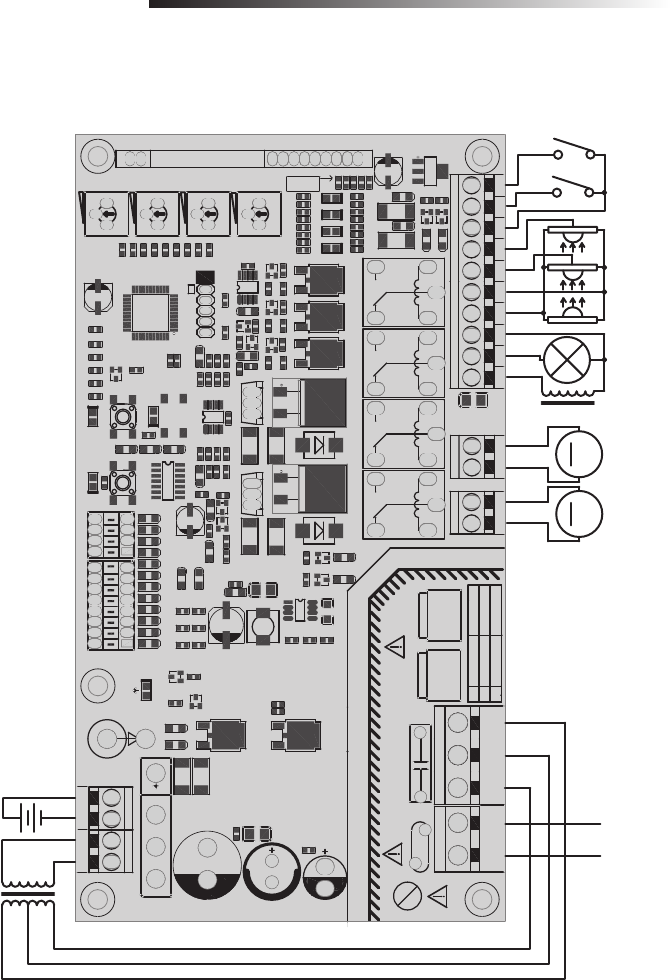
15
CONEXIONES
110-127 Vac
OFF
ON
ON
OFF
J3
J2
230V127VN
POWER LINE
GND
GND
S1COM S2COM
IAD:1
IAD:2
VCCAD
RP3
RP1
RP2
RP4
+
++
-- -
BATAD
+24V
+3.3V
+5V
CHAR
VCC33V
Pb
ET-LA350-R NO.06 2013.9.20
4
3
21
87654321
OFF
ON
-BATTERY+24V AC IN
Charging
+MOTO2- Gate1Gate2
GNDIR2IR1GND
IR.V+
GND
DC.L+Lock+
+MOTO1-
Transformer In
NL
SBC
LEARN
FORCE
RV LV
TIMER
SBC1SBC
IR2IR1
220-240 Vac
Indicator
J3
J2
R78
R77
R80
IC6
VT2-B
VT1-B
Q18
RP3
C30
D33
SW1
D8
R75
R72
R70
R73
R71
R68
Q15
Q17
Q14
LED2
LED3
LED1
SW3
C32
C1
C2
C5
C6
C7
C8
C9
C10
C11
C12
C13
C14
C17
C19
C20
C21
C22
C23
C24
C25
C29
C31
C33
C35
C36
C37
C38
C39
C40
C41
C42
C43
CON1CON2
CON5
CON6
CON7
D1
D2
D3
D4
D5
D6
D7 D9
D10
D11
D12
D13
D14
D15
D16
D17
D18
D19
D20
D21
D22
D23
D24
D25
D26
D27
D36
D29
D30
D31
D32
D34
D35
DB1
DZ2
DZ1
IC1
IC2
IC3
IC4
IC5
J1
K1
K2
K3
K4
L1
LED4
LED5
LED6
LED7
LED8
Q1
Q2 Q3
Q4
Q5
Q6
Q7 Q8
Q9
Q12
Q11
Q13
Q16
Q19
R1
R2
R3
R4
R5
R6
R7
R8
R9
R10
R11
R12
R13
R14
R15
R16
R17
R18
R19 R20
R21
R22
R23
R24
R25
R26
R27
R28
R29
R30
R31
R32
R33
R34
R35
R36
R37
R38
R39 R40
R41
R43
R44
R45
R46
R47
R48
R49
R50
R51
R52
R53
R54
R55
R56
R57 R58
R59
R60
R62
R61
R64
R63
R65
R66 R67
R69
R74
R76
RF1
RP1
RP2
RP4
S1 S2
U1
VT1
VT2
C18
CON4
RV1
CON3
DZ3
R100
1
1
MM
LN
ALIMENTACIÓN ELÉCTRICA
Motor de 24 VCC CERRA-
DURA
Lámpara
de CC IR TX IR RX1,2 Puerta1,2
Batería de 24 V
Transformador de 24 V
Azul
Marrón
Azul
Marrón
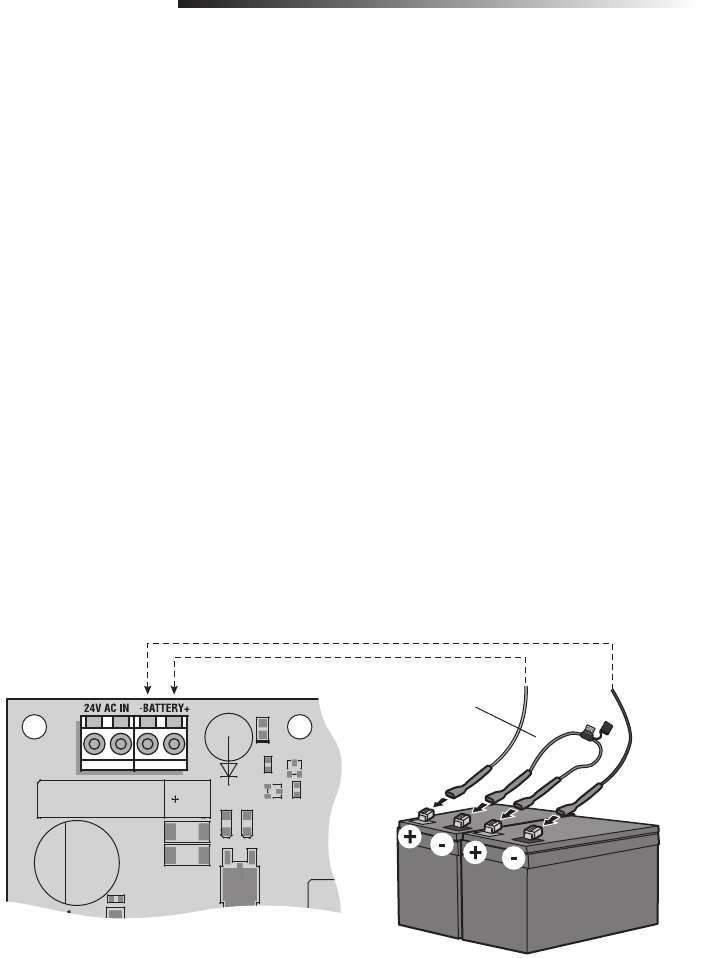
16
CONEXIONES
Conectar a la caja de control la línea de reserva de batería (opcional)
Las baterías se cargan a través del circuito con el transformador.
Elementos recomendados para uso con una batería de reserva (no suministrados):
• Dos baterías de 12 V, 4 A-H (McNair Modelo RB-FM-12V-4AH)
• Caja de batería (Attwood Modelo 9069-1)
• 3 x 18 AWG (1.00 mm) VM-1 105°C 600 V, 1 cable debe tener fusible de 10 A/250 V
1. Desconectar la alimentación eléctrica al operador.
2. Determinar qué orifi cio del fondo del tablero se usará para el cable de la batería (no suministrado).
3. Introducir el conector hermético (no suministrado) en el fondo del tablero y ajustar la tuerca.
4. Pasar el cable de la batería por el conector hermético instalado en el fondo del tablero.
5. Conectar el cable de la batería al terminal BATTERY de la tarjeta de control.
6. Ajustar bien la tuerca del conector pasante.
7. Instalar la caja de la batería (a no más de 3 m de distancia).
9. Colocar las baterías en la caja.
10 Conectar un puente con fusible entre el positivo (+) de una batería y el negativo (-) de la otra.
11. Conectar el cable del positivo de batería al terminal positivo (+) de la batería.
12. Conectar el cable del negativo de batería al terminal negativo (-) de la otra batería.
13. Conectar la alimentación eléctrica al operador.
TARJETA DE CONTROL Puente con
fusible de
10 A/250 V
(no suministrado)
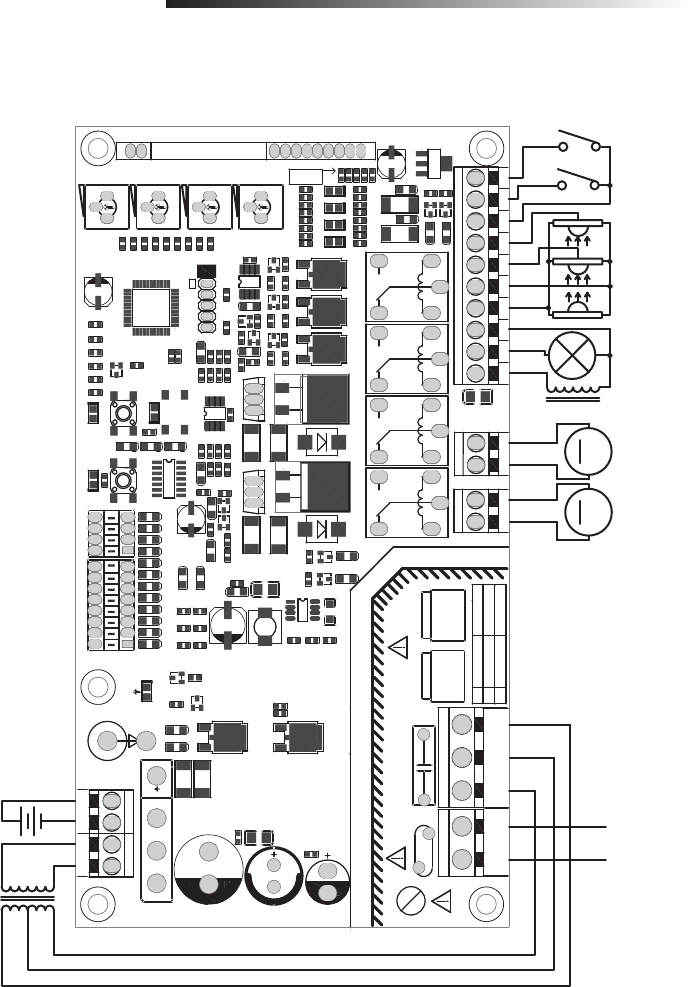
17
CONEXIONES
Diagrama de conexiones
SBC es un comando de apertura/cierre para portón de una sola hoja.
NOTA: SBC también se utiliza para calibrar el límite de
desplazamiento junto con en N° 8 de S1 en la posición ON.
110-127 Vac
OFF
ON
ON
OFF
J3
J2
230V127VN
POWER LINE
GND
GND
S1COM S2COM
IAD:1
IAD:2
VCCAD
RP3
RP1
RP2
RP4
+
++
-- -
BATAD
+24V
+3.3V
+5V
CHAR
VCC33V
Pb
ET-LA350-R NO.06 2013.9.20
4
3
21
87654321
OFF
ON
-BATTERY+24V AC IN
Charging
+MOTO2-
Gate1Gate2
GNDIR2IR1GND
IR.V+
GND
DC.L+Lock+
+MOTO1-
Transformer In
NL
SBC
LEARN
FORCE
RV LV
TIMER
SBC1SBC
IR2IR1
220-240 Vac
Indicator
J3
J2
R78
R77
R80
IC6
VT2-B
VT1-B
Q18
RP3
C30
D33
SW1
D8
R75
R72
R70
R73
R71
R68
Q15
Q17
Q14
LED2
LED3
LED1
SW3
C32
C1
C2
C5
C6
C7
C8
C9
C10
C11
C12
C13
C14
C17
C19
C20
C21
C22
C23
C24
C25
C29
C31
C33
C35
C36
C37
C38
C39
C40
C41
C42
C43
CON1CON2
CON5
CON6
CON7
D1
D2
D3
D4
D5
D6
D7 D9
D10
D11
D12
D13
D14
D15
D16
D17
D18
D19
D20
D21
D22
D23
D24
D25
D26
D27
D36
D29
D30
D31
D32
D34
D35
DB1
DZ2
DZ1
IC1
IC2
IC3
IC4
IC5
J1
K1
K2
K3
K4
L1
LED4
LED5
LED6
LED7
LED8
Q1
Q2 Q3
Q4
Q5
Q6
Q7 Q8
Q9
Q12
Q11
Q13
Q16
Q19
R1
R2
R3
R4
R5
R6
R7
R8
R9
R10
R11
R12
R13
R14
R15
R16
R17
R18
R19 R20
R21
R22
R23
R24
R25
R26
R27
R28
R29
R30
R31
R32
R33
R34
R35
R36
R37
R38
R39 R40
R41
R43
R44
R45
R46
R47
R48
R49
R50
R51
R52
R53
R54
R55
R56
R57 R58
R59
R60
R62
R61
R64
R63
R65
R66 R67
R69
R74
R76
RF1
RP1
RP2
RP4
S1 S2
U1
VT1
VT2
C18
CON4
RV1
CON3
DZ3
R100
1
1
MM
LN
ALIMENTACIÓN ELÉCTRICA
Motor de 24 VCC CERRA-
DURA
Lámpara
de CC IR TX IR RX1,2 Puerto1,2
Batería de 24 V
Transformador de 24 V
Azul
Marrón
Azul
Marrón
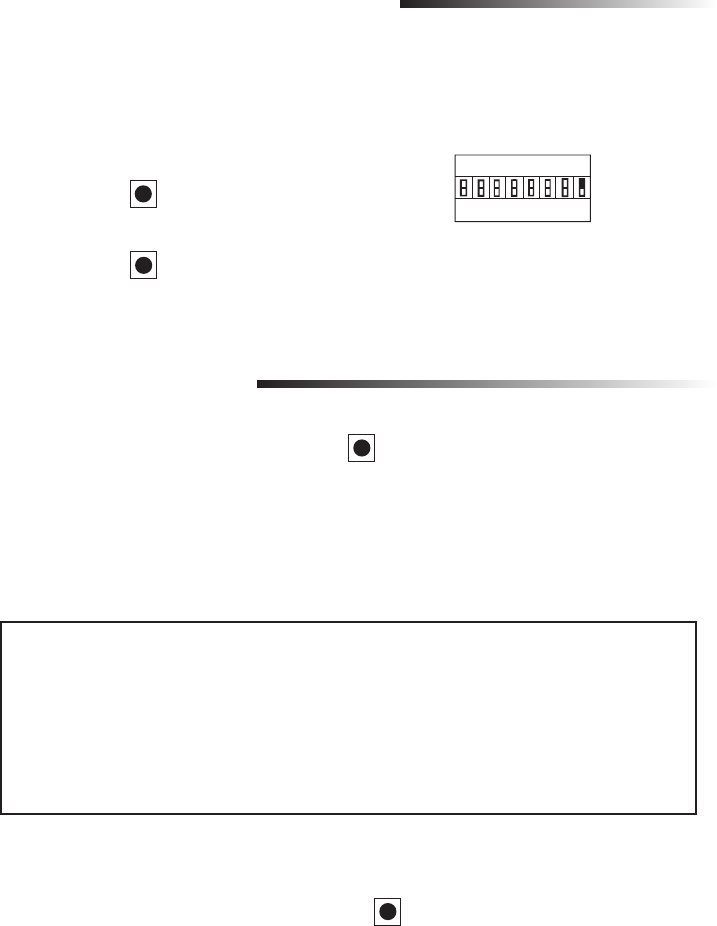
18
1. Liberar el embrague de ambos operadores con la llave correspondiente. Abrir totalmente ambas
hojas del portón y acoplar los respectivos embragues.
2. Poner el microselector N° 8 en la posición ON.
3. Pulsar el botón en la tarjeta de control y ambas
hojas del portón se cerrarán totalmente.
4. Pulsar el botón nuevamente y ambas hojas del portón se abrirán totalmente.
5. Poner el microselector N° 8 en la posición OFF.
ON
OFF
1 2 3 4 5 6 7 8
S1
SBC
SBC
CALIBRACIÓN DE LÍMITES
DE DESPLAZAMIENTO
PROGRAMACIÓN
NOTIFICACIÓN: El uso está sujeto a las siguientes condiciones: (1) Este dispositivo no debe causar interferencia perjudicial, y (2) este
dispositivo debe poder recibir interferencia, incluso interferencia que pueda afectar su funcionamiento.
Cualquier cambio o modifi cación no aprobados explícitamente por la parte responsable del cumplimiento, podría anular la autoridad del
usurario para operar el equipo.
Este dispositivo está diseñado para proporcionar una protección razonable contra las interferencias dañinas en una instalación residencial.
Este equipo genera, usa y puede emitir energía de radiofrecuencia. Si no se instala y utiliza de acuerdo con las instrucciones podrá causar
interferencia con comunicaciones radiales. Aun así, no hay garantía de que no se produzcan interferencias en una instalación particular. Si este
equipo produce interferencia en la recepción de radio o televisión, lo cual puede determinarse apagando y encendiendo la unidad, el usuario es
alentado a:
- Conectar el equipo a un tomacorriente de un circuito eléctrico diferente al que esté conectado el receptor.
- Consultar al distribuidor del producto o a un técnico idóneo de radio y televisión.
Programar el control remoto
1. Oprimir y soltar el botón LEARN (aprendizaje) (se encenderá el LED1).
2. Pulsar el botón del control remoto que se desea programar con el operador.
El operador saldrá automáticamente del modo de aprendizaje cuando haya fi nalizado la programación
(el LED1 parpadeará y se apagará). Para programar otros controles remotos Security✚ 2.0™ repetir los
pasos anterior de programación. Pulsar otra vez el botón LEARN (aprendizaje) para salir del modo de
programación en cualquier momento.
LEARN
Borrar todos los códigos
1. Mantener oprimido el botón LEARN (aprendizaje) (se encenderá el LED1).
2. Mantenerlo oprimido durante aproximadamente 6 segundos. El LED1 se apagará y se borrarán los
códigos del control remoto.
LEARN

19
PROGRAMACIÓN
LiftMaster® Internet Gateway
Para programar el operador con el LiftMaster® Internet Gateway:
1. Conectar el cable de Ethernet al LiftMaster® Internet Gateway y al router.
2. Conectar la alimentación eléctrica al LiftMaster® Internet Gateway.
3. Crear una cuenta por Internet en el sitio www.myliftmaster.com.
4. Registrar el LiftMaster® Internet Gateway.
5. Agregue dispositivos con una computadora o un teléfono inteligente vía Internet. El LiftMaster®
Internet Gateway permanecerá en modo de aprendizaje durante tres minutos.
6. Pulse el botón LEARN (aprendizaje) en el operador (el LED1 se encenderá en modo de
aprendizaje). El LiftMaster® Internet Gateway se conectará al operador si la distancia es adecuada,
y el LED1 parpadeará y se apagará si la programación se hubiera realizado.
Borrar la memoria de un LiftMaster® Internet Gateway
1. Mantener oprimido el botón LEARN (aprendizaje) (se encenderá el LED1).
2. Mantenerlo oprimido durante aproximadamente 6 segundos. El LED1 se apagará y se borrarán los
códigos del control remoto.
3. Mantener oprimido el botón LEARN (aprendizaje) por segunda vez (se encenderá otra vez el LED1).
4. Mantenerlo oprimido durante aproximadamente 6 segundos. El LED1 se apagará y se borrarán los
códigos Gateway.
LEARN
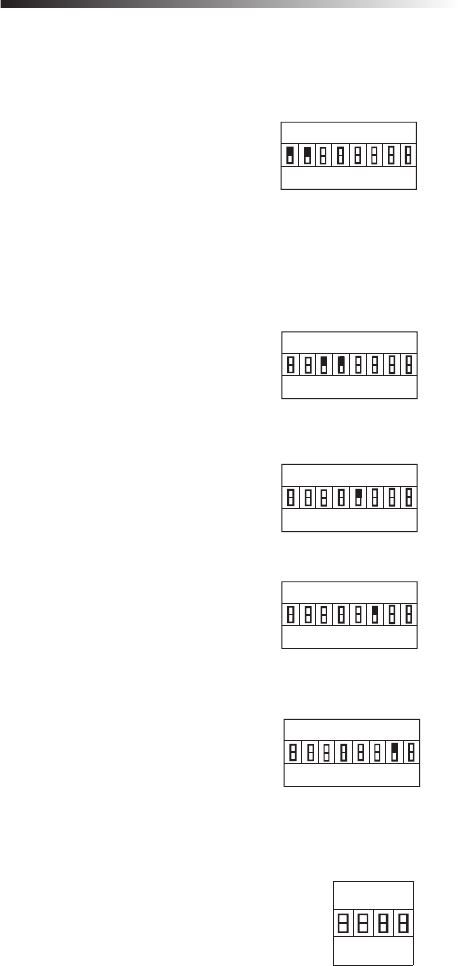
20
Calibración del retardo de apertura y cierre
La calibración de fábrica es de 2 segundos.
Las demoras de apertura y cierre pueden programarse
individualmente entre 1 y 4 segundos.
Demora de apertura:
1 OFF y 2 OFF = 1 segundo
1 ON y 2 OFF = 2 segundos
1 OFF y 2 ON = 3 segundos
1 ON y 2 ON = 4 segundos
El retardo mínimo es 1 segundo.
Demora de cierre:
3 OFF y 4 OFF = 1 segundo
3 ON y 4 OFF = 2 segundos
3 OFF y 4 ON = 3 segundos
3 ON y 4 ON = 4 segundos
El retardo mínimo es 1 segundo.
Programación para portón de una sola hoja
5 ON = Operador MOTO1 es el único disponible.
5 OFF = Operadores MOTO1 y MOTO2 disponibles.
Programación del modo de funcionamiento
6 ON = Modo de funcionamiento es:
ABRE-PARADA-CIERRA-ABRE
6 OFF = Modo de funcionamiento es:
ABRE-PARADA-CIERRA-PARADA-ABRE
Ajuste de cierre automático de tiempo
La posición preasignada de esta función es desactivada (OFF).
El tiempo puede calibrarse de 0 a 105 segundos.
1 = 15 s 2 = 30 s 3 = 60 s
Si todos los microselectores están en posición ON, el tiempo
de cierre automático es de 105 segundos. Si todos los microselectores
están en la posición OFF, la hoja del portón no se cerrará automáticamente.
ON
OFF
1 2 3 4 5 6 7 8
S1
Demora de apertura
programada en 4 segundos
CONFIGURACIÓN
Únicamente MOTO1
ON
OFF
S2
1 2 3 4
ON
OFF
1 2 3 4 5 6 7 8
S1
ON
OFF
1 2 3 4 5 6 7 8
S1
ON
OFF
1 2 3 4 5 6 7 8
S1
ON
OFF
1 2 3 4 5 6 7 8
S1
ABRE-PARADA-CIERRA-ABRE
Demora de cierre
programada en 4 segundos

21
Regulación de la fuerza
Girar el botón de FUERZA en sentido horario para
incrementar la fuerza del portón. Girar el botón de
FUERZA en sentido antihorario para disminuir la fuerza
del portón.
Calibración de arranque lento y velocidad de
parada
Girar el botón LV en sentido horario para aumentar la
velocidad. Girar el botón LV en sentido antihorario para
disminuir la velocidad.
Calibración de la velocidad de movimiento
Girar el botón RV en sentido horario para aumentar la
velocidad del portón en movimiento. Girar el botón RV
en sentido antihorario para disminuir la velocidad del
portón en movimiento.
Calibración del tiempo de funcionamiento
Girar el botón del TEMPORIZADOR en sentido horario
para aumentar el tiempo de funcionamiento. Girar
el botón del TEMPORIZADOR en sentido antihorario
para disminuir el tiempo de funcionamiento. El tiempo
puede calibrarse entre un máximo de 60 segundos y un
mínimo de 30 segundos.
Menos
fuerza
Más
fuerza
LVRV FORCETIMER
LVRV FORCETIMER
LVRV FORCETIMER
Más lentoMás rápido
Más
lento
Más
rápido
CONFIGURACIÓN
Menos
tiempo
Más
tiempo
LVRV FORCETIMER

22
Cerradura magnética (opcional)
Los conectores LOCK y GND en la tarjeta corresponden al MG1300 MAGLOCK
(24 V/250 mA). Al conectarse la maglock, la cerradura se abrirá antes de que el portón se abra.
Luz intermitente (opcional)
Los conectores DCL y GND en la tarjeta corresponden a la luz intermitente FA42LM. La luz
intermitente se encenderá antes de que el portón se abra.
Conexión del sensor fotoeléctrico (opcional)
El contacto del sensor fotoeléctrico es normalmente cerrado. Si no se instalan los sensores
fotoeléctricos, conectar el terminal IR1 al terminal GND con un puente y el terminal IR2 al terminal
GND con otro puente para que el operador funcione correctamente. Los puentes vienen instalados
de fábrica. Si se usa IR1 o IR2, dejar el otro par de terminales conectados con un puente.
Cuando el haz de un sensor fotoeléctrico IR1 es interrumpida por obstáculos, la portón se detendrá
e invertir durante el cierre o parada durante la apertura. IR1 LED en el panel de control se apagará.
Cuando el haz de un sensor fotoeléctrico IR2 es interrumpida por obstáculos, la hoja de portón se
detendrá en cualquier dirección. IR2 LED en el panel de control se apagará.
CONFIGURACIÓN

23
USO Y MANTENIMIENTO
• LEA Y CUMPLA TODAS LAS INSTRUCCIONES.
• NO permita que los niños usen ni jueguen con los controles de un portón. Mantenga el control
remoto alejado de los niños.
• Mantenga SIEMPRE a la gente y los objetos alejados del portón. NADIE DEBE ATRAVESAR EL
RECORRIDO DEL PORTÓN EN MOVIMIENTO.
• Probar el funcionamiento del operador del portón una vez por mes. El portón DEBE invertir su
dirección al entrar en contacto con un objeto rígido o detenerse cuando se activan los sensores
sin contacto. Probar el sistema después de regular la fuerza o el límite de desplazamiento del
operador. Si el operador de portón no se regula correctamente ni se prueba, habrá más riesgo de
accidentes con GRAVES LESIONES e INCLUSO FATALES.
• Usar el desacople de emergencia ÚNICAMENTE si el portón no está en movimiento.
• MANTENGA EL PORTÓN EN BUENAS CONDICIONES DE USO. Consultar el manual de
instrucciones. Use los servicios de un técnico profesional para reparar el portón.
• La entrada / salida está adaptado para vehículos. Los peatones deben ser provistos de una vía de
acceso independiente.
• Haga funcionar el portón SOLAMENTE si lo puede ver claramente, si está correctamente
calibrado y si no hay ninguna obstrucción en su recorrido.
• Usar dispositivos de seguridad tanto para apertura como para cierre.
• CONSERVAR ESTAS INSTRUCCIONES.
PRECAUCIÓN ADVERTENCIA
ADVERTENCIA
ADVERTENCIA
INSTRUCCIONES IMPORTANTES DE SEGURIDAD

24
Para reducir el riesgo de LESIONES GRAVES o la MUERTE:
• Desconectar la alimentación eléctrica ANTES de hacer mantenimiento.
• El mantenimiento DEBE ser realizado por un técnico profesional de LiftMaster®.
• Usar SIEMPRE guantes y gafas de seguridad para trabajar con la batería.
PRECAUCIÓN ADVERTENCIA
ADVERTENCIA
ADVERTENCIA
Mantenimiento
USO Y MANTENIMIENTO
INSPECCIONAR AL MENOS UNA VEZ CADA
DESCRIPCIÓN TAREA MES 3 MESES 6 MESES 12 MESES
Sistemas de
protección contra
atrapamiento
externo
Probar el
funcionamiento •
Inspección completa
Letreros de
seguridad Verifi car que no falte
ninguno •
Liberación
manual Probar el
funcionamiento •
Portón Verifi car que no haya
desgaste ni averías •
Accesorios Probar el
funcionamiento de
todos
•
Instalación
eléctrica Inspeccionar todas
las conexiones •
Unidad completa Verifi car que no haya
desgaste ni averías •
Cuadro de mantenimiento

25
USO Y MANTENIMIENTO
Un operador de portón tiene diferentes materiales. Algunos de ellos pueden reciclarse, tales como
aluminio, hierro, plástico, cables, etc., pero no todos son reciclables.
1. Desconectar la alimentación eléctrica del operador.
2. Desarmar el equipo y los accesorios.
3. Quitar la batería de reserva en la caja de control y la batería del control remoto.
4. Desmontar la caja de control.
5. Entregar los materiales reciclables a una compañía local de desecho.
6. La batería de reserva y del control remoto, la caja de control, etc. deben entregarse a una compañía
de reciclaje para evitar la contaminación ambiental.
Las baterías de plomo-ácido y ciertos materiales de electrónica son materiales perjudiciales.
Para evitar la contaminación ambiental deben desecharse y reciclarse según las normas vigentes
locales.
PRECAUCIÓN ADVERTENCIA
ADVERTENCIA
ADVERTENCIA
Reciclaje

26
Problema Causa Solución
El operador no
funciona. 1. El enchufe no está bien
conectado. 1. Pedir a un técnico profesional que
conecte la alimentación eléctrica.
El operador no funciona
con el control remoto. 1. El control remoto no se ha
programado.
2. Cambiar la batería del
control remoto.
3. El embrague está
desacoplado.
1. Programar el control remoto. Véase la
página 18.
2. Cambiar las pilas.
3. Acoplar el embrague con la llave
correspondiente.
La distancia del control
remoto es corta. Cambiar la batería del control
remoto. Cambiar la batería con una del mismo
tipo.
El portón se mueve muy
despacio. 1. El portón no se instaló
correctamente.
2. La velocidad de movimiento
no está calibrada
correctamente.
1. Liberar el embrague y mover a mano
el portón para verifi car que se mueva
normalmente.
2. Calibrar la velocidad de movimiento
según las instrucciones de la página
21.
La hoja del portón
no abre ni cierra
completamente, o no se
mueve.
1. El sensor fotoeléctrico está
obstruido.
2. El tiempo de funcionamiento
del operador no está
calibrado correctamente.
1. Verifi car que el sensor fotoeléctrico
no esté obstruido.
2. Calibrar el tiempo de funcionamiento
según las instrucciones de la página
21.
El portón no se cierra
automáticamente. 1. La función de cierre
automático está
desactivada.
2. Las conexiones no fueron
realizadas correctamente.
1. Programar el tiempo de cierre
automático según las instrucciones de
la página 20.
2. Revisar las conexiones según el
esquema de la página 17.
DIAGNÓSTICO DE FALLAS
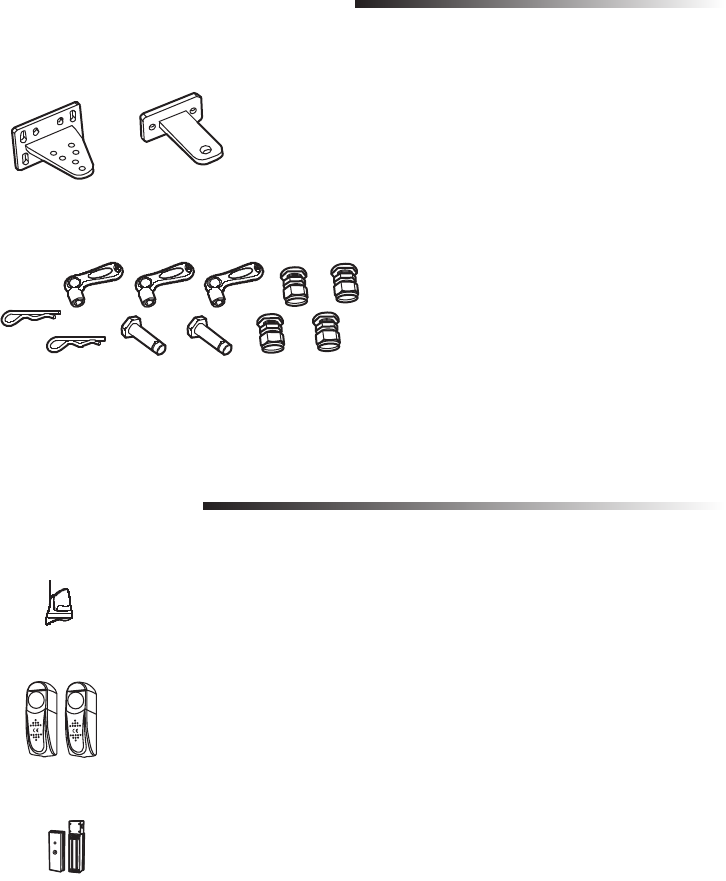
27
JUEGOS DE REPUESTO
K80-36930 Juego de soportes LA350
K80-36931 Ferretería de LA350
FA42LM Luz intermitente
FA31LM Sensor fotoeléctrico
MG1300 Cerradura magnética
ACCESORIOS
Apoyo técnico:
americalatina@chamberlain.com
K2A1832 Tabla de control LA350
FA70LM Caja de control LA350
TX4UNI Transmisor de cuatro canales EVO
© 2014, The Chamberlain Group Inc.
All Rights Reserved
01-36883D Todos los Derechos Reservados